World-Class PGE-Cu-Ni Talnakh Deposit: New Data on the Structure and Unique Mineralization of the South-Western Branch
Abstract
:1. Introduction
2. Brief Description of the Geology of the Norilsk Area and the Talnakh Intrusion
2.1. General Characteristic of the Area
2.2. Deep Structure of the Area
2.3. The Position of the Intrusions
3. Materials and Methods
4. Results
4.1. Morphology of the Branches of the Talnakh Intrusion
4.2. Internal Structure of the Intrusive Branches
4.3. The Southern 2 Orebody
4.3.1. Morphology
4.3.2. Chemical Composition of the Ores
4.3.3. Mineral Composition of the Ores
4.3.4. Minerals of Platinum Group Elements (PGM)
5. Discussion
6. Conclusions
Acknowledgments
Author Contributions
Conflicts of Interest
References
- Sotnikov, A.A. About Exploration of the Norilsk (Dudinsky) Coal and Copper Deposit in Term of Creating of Northern Marine Route; Gubernsky typography: Tomsk, Russia, 1919; p. 54. (In Russian) [Google Scholar]
- Godlevsky, M.N. Traps and Ore-Bearing Intrusions of the Norilsk District; Gosgeoltekhizdat: Moscow, Russia, 1959; p. 61. [Google Scholar]
- Godlevsky, M.N.; Likhachev, A.P. Types and distinctive features of ore-bearing formations of copper-nickel deposits. In Geology and Metallogeny of Copper Deposits; Nauka: Moscow, Russia, 1984; pp. 124–134. (In Russian) [Google Scholar]
- Likhachev, A.P. The Role of Leucocratic Gabbro in the Origin of Norilsk Differentiated Intrusions. Izv. Akad. Nauk SSSR Ser. Geol. 1965, 12, 50–56. (In Russian) [Google Scholar]
- Likhachev, A.P. Ore-bearing intrusions of the Noril’sk region. In Proceedings of the Sudbury-Noril’sk Symposium; Ontario Geological Survey: Sudbury, ON, Canada, 1994; pp. 185–201. [Google Scholar]
- Likhachev, A.P. The Kharaelakh intrusion and its PGM-Cu-Ni ores. Rudy and Metals 1996, 3, 48–62. (In Russian) [Google Scholar]
- Likhachev, A.P. Trap magmatism and Platinum-Copper-Nickel ore mineralization in the Norilsk District. Otech. Geol. 1997, 10, 8–19. (In Russian) [Google Scholar]
- Likhachev, A.P. Platinum-Copper-Nickel and Platinum Deposits; Eslan: Moscow, Russia, 2006; p. 496. [Google Scholar]
- Dodin, D.A.; Batuev, B.N. Geology and petrology of the Talhakh differentiated intrusions and their metamorphic aureole. In Petrology and Ore Resource Potential of the Talnakh and Norilsk Differentiated Intrusions; Nedra: Leningrad, Russia, 1971; pp. 31–100. (In Russian) [Google Scholar]
- Zolotukhin, V.V. Trap Magmatism and Formation Conditions of Ore-Bearing Differentiated Intrusions of the Siberian Platform. In Traps of the Siberian Platform and Their Metallogeny; Institut zemnoi Kory: Irkutsk, Russia, 1971; pp. 53–59. (In Russian) [Google Scholar]
- Zotov, I.A. The Genesis of Trap Intrusions and Metamorphic Rocks of Talnakh; Nauka: Moscow, Russia, 1979; p. 187. (In Russian) [Google Scholar]
- Zotov, I.A. Transmagmatic Fluids in Magmatism and Ore Mineralization; Nauka: Moscow, Russia, 1989; p. 213. (In Russian) [Google Scholar]
- Ryabov, V.V. About composition of upper horizons of the Norilsk intrusions with rich chromite mineralization. In Criteria of ore Potential of Magmatic Rocks; Nauka: Novosibirsk, Russia, 1984; pp. 124–142. (In Russian) [Google Scholar]
- Ryabov, V.V. Olivines from Norilsk Intrusions as Criteria of Petrogeneses and Ore Producing Process; Nauka: Novosibirsk, Russia, 1992; p. 182. (In Russian) [Google Scholar]
- Ryabov, V.V.; Tsimbalist, V.G.; Yakobi, I.Y. About PGE and chromium concentrations in the upper zones of the Norilsk intrusions. Doclady Earth Sci. 1982, 266, 466–469. (In Russian) [Google Scholar]
- Ryabov, V.V.; Shevko, A.Y.; Gora, M.P. Igneous Rocks of the Norilsk District. V.1. Petrology of Traps; Nonparel: Novosibirsk, Russia, 2000; Volume 1–2. (In Russian) [Google Scholar]
- Ryabov, V.V.; Shevko, A.Y.; Gora, M.P. Trap Magmatism and Ore Formation in the Siberian Norilsk Region Nederland; Springer: New York, NY, USA, 2014; Volume 1–2. [Google Scholar]
- Dyuzhikov, O.A.; Distler, V.V.; Strunin, B.M. Geology and Ore Potential of the Norilsk Ore District; Nauka: Moscow, Russia, 1988; p. 248. [Google Scholar]
- Dyuzhikov, O.A.; Distler, V.V.; Strunin, B.M.; Mkrtychyan, A.K.; Sherman, M.L.; Sluzhenikin, S.F.; Lurye, A.M. Geology and Metallogeny of Sulfide Deposits Norilsk Region USSR; PUBCO: Cleveland, OH, USA, 1992; p. 241. [Google Scholar]
- Distler, V.V.; Grokhovskaya, T.L.; Evstigneeva, T.L.; Sluzhenikin, S.F.; Filimonova, A.A.; Dyuzhikov, O.A. Petrology of Magmatic Sulfide Ore Formation; Nauka: Moscow, Russia, 1988; p. 232. (In Russian) [Google Scholar]
- Naldrett, A.J. A model for the Ni-Cu-PGE Ores of the Norilsk Region and Its Application to Other Areas of Flood Basalts. Econ. Geol. 1992, 87, 1945–1962. [Google Scholar] [CrossRef]
- Naldrett, A.J. Magmatic Sulphide Deposits: Geology, Geochemistry and Exploration; Springer: Berlin/Heidelberg, Germany; New York, NY, USA, 2004; p. 727. [Google Scholar]
- Krivolutskaya, N.A.; Ariskin, A.A.; Sluzhenikin, S.F.; Turovtsev, D.M. Geochemical thermometry of rocks of the Talnakh Intrusion: Assessment of the melt composition and the crystallinity of the parental magma. Petrology 2001, 9, 389–414. [Google Scholar]
- Krivolutskaya, N.A.; Sobolev, A.V.; Snisar, S.G. Mineralogy, geochemistry and stratigraphy of the Maslovsky Pt-Cu-Ni sulfide deposit, Norilsk Region, Russia: Implications for relatioship of ore-bearing intrusions and lavas. Miner. Depos. 2012, 47, 69–88. [Google Scholar] [CrossRef]
- Lightfoot, P.C.; Zotov, I.A. Geological relationships between intrusions, country rocks and Ni-Cu-PGE sulfides of the Kharaelakh intrusion, Norilsk region: Implication for the role of sulfide differentiation and metasomatism in their genesis. Northwest. Geol. 2014, 47, 1–34. [Google Scholar]
- Malich, K.N.; Latypov, R.M. Re-Os and S isotope constraints on timing and source heterogeneity of PGE-Cu-Ni sulfide ores: A case study at the Talnakh ore junction, Norilsk province, Russia. Can. Miner. 2011, 49, 1653–1677. [Google Scholar] [CrossRef]
- Malitch, K.N.; Belousova, E.A.; Griffin, W.L.; Badanina, I.Y.; Pearson, N.J.; Presnyakov, S.L.; Tuganova, E.V. Magmatic evolution of the ultramafic–mafic Kharaelakh intrusion (Siberian Craton, Russia): Insights from trace-element, U-Pb and Hf-isotope data on zircon. Contrib. Miner. Pet. 2010, 159, 753–768. [Google Scholar] [CrossRef]
- Malitch, K.N.; Belousova, E.A.; Griffin, W.L.; Badanina, I.Y. Hafnium-neodymium constraints on source heterogeneity of the economic ultramafic-mafic Norilsk-1 intrusion (Russia). Lithos 2013, 164–167, 36–46. [Google Scholar] [CrossRef]
- Malitch, K.N.; Badanina, I.Y.; Puchkov, V.N.; Belousova, E.A.; Stepashko, A.A. Results of U-Pb dating of zircons from wehrlite of the platinum-bearing Feklistov massif (Shantar Archipelago, Russia). Dokl. Earth Sci. 2017, 475, 762–765. [Google Scholar] [CrossRef]
- Malitch, K.N.; Belousova, E.A.; Griffin, W.L.; Badanina, I.Y.; Latypov, R.S.; Sluzhenikin, S.F. Chapter 7—New insights on the origin of ultramafic-mafic intrusions and associated Ni-Cu-PGE sulfide deposits of the Norilskand Taimyr provinces, Russia:Evidence From Radiogenic- And Stable-Isotope Data. In Processes and Ore Deposits of Ultramafic-Mafic Magmas through Space and Time; Mondal, S., Griffin, W.L., Eds.; Elsevier Inc.: Amsterdam, The Netherlands, 2017; pp. 197–238. [Google Scholar]
- Sluzhenikin, S.F.; Krivolutskaya, N.A.; Rad’ko, V.A.; Malitch, K.N.; Distler, V.V.; Fedorenko, V.A. Ultramafic-Mafic Intrusions, Volcanic Rocks and PGE-Cu-Ni Sulfide Deposits of the Norilsk Province, Polar Siberia Field Trip Guidebook; Zavaritsky Institute of Geology and Geochemistry of the Ural Branch (UB) of the Russian Academy of Sciences (RAS): Yekaterinburg, Russia, 2014; p. 87. [Google Scholar]
- Spiridonov, E.M. The ore-magmatic system of the Norilsk ore field. Rus. Geol. Geophys. 2010, 51, 1059–1077. [Google Scholar] [CrossRef]
- Spiridonov, E.M.; Kulagov, E.A.; Serova, A.A.; Kulikova, I.M.; Korotaeva, N.N.; Sereda, E.V.; Tushentsova, I.N.; Belova, S.N.; Zhukov, N.N. Genetic mineralogy of Pd, Pt, Au, Ag, and Rh at the Norilsk sulfide ores. Geol. Ore Depos. 2015, 57, 382–402. [Google Scholar] [CrossRef]
- Krivolutskaya, N.A. Siberian Traps and Pt-Cu-Ni Deposits in the Norilsk Area; Springer: Amsterdam, The Netherlands, 2016; p. 361. [Google Scholar]
- Malitch, K.N.; Khiller, V.V. Results of chemical dating of monazite from the Talnakh economic intrusion. Dokl. Earth Sci. 2017, 474, 565–568. [Google Scholar] [CrossRef]
- Kamo, S.L.; Czamanske, G.K.; Amelin, Y.A. Rapid eruption of Siberian flood-volcanic rocks and evidence for coincidence with the Permian-Triassic boundary and mass extinction at 251 Ma. Earth Plan. Sci. Lett. 2003, 214, 75–91. [Google Scholar] [CrossRef]
- Burgess, S.D.; Bowring, S.A. High-precision geochronology confirms voluminous magmatism before, during, and after Earth’s most severe extinction. Sci. Adv. 2015, 1, e1500470. [Google Scholar] [CrossRef] [PubMed]
- Zolotukhin, V.V.; Ryabov, V.V.; Vasil’ev, Y.R.; Shatkov, V.A. Petrology of the Talnakh Ore-Bearing Differentiated Trap Intrusion; Nauka: Novosibirsk, Russia, 1975; p. 425. (In Russian) [Google Scholar]
- Rad’ko, V.A. Model of dynamic differentiation of intrusive traps at the northwestern siberian trap. Geol. Geophys. 1991, 32, 19–27. (In Russian) [Google Scholar]
- Rad’ko, V.A. Facies of Intrusive and Volcanic Magmatism in the Norilsk District; Map-Making Department at VSEGEI: St. Petersburg, Russia, 2016; p. 285. (In Russian) [Google Scholar]
- Li, C.; Ripley, E.M.; Naldrett, A.J. A new genetic model for the giant Ni-Cu-PGE sulfide deposits associated with the Siberian flood basalts. Econ. Geol. 2009, 104, 291–301. [Google Scholar] [CrossRef]
- Le Vaillant, M.; Barnes, S.J.; Mungall, J.E.; Mungall, E.L. Role of degassing of the Norilsk nickel deposits in the Permian-Triassic mass extinction event. PNAS 2017, 114, 2485–2490. [Google Scholar] [CrossRef] [PubMed]
- Genkin, A.D.; Distler, V.V.; Gladyshev, G.D.; Filimonova, A.A.; Evstigneeva, T.L.; Kovalenker, V.A.; Laputina, I.P.; Smirnov, A.V.; Grokhovskaya, T.L. Sulfide Copper–Nickel Ores of the Norilsk Deposits; Nauka: Moscow, Russia, 1981; p. 374. [Google Scholar]
- Sukhanova, E.N. Zoning of orebodies, intrusions, and tectonomagmatic clusters and its applied implications. In Geology and Mineral Resources of the Norilsk Mining District; NTO Tsvetmet: Norilsk, Russia, 1968; pp. 139–142. (In Russian) [Google Scholar]
- Torgashin, A.S. Geology of the massive and copper ore of the Western part of the Octyabr’sky deposit. In Proceeding of the Norilsk-Sudbury Symposium; Ontario Geological Survey: Sudbury, ON, Canada, 1994; pp. 231–242. [Google Scholar]
- Stekhin, A.I. Mineralogical and geochemical characteristics of the Cu-Ni ores of the Oktyabr’skoe and Talnakh deposits. In Proceeding of the Norilsk-Sudbury Symposium; Ontario Geological Survey: Sudbury, ON, Canada, 1994; pp. 231–242. [Google Scholar]
- Distler, V.V. Platinum Mineralization of the Norilsk Deposits, Proceeding of the Sudbury-Norilsk Symposiun. Sudbury Spec. 1994, 5, 243–260. [Google Scholar]
- 48. Naldrett, A.J.; Fedorenko, V.A.; Asif, M.; Lin, S.; Kunilov, V.E.; Stekhin, A.I.; Lightfoot, P.C.; Gorbachev, N.S. Controls on the composition of Ni-Cu sulfide deposits as illustrated by those at Norilsk, Siberia. Econ. Geol. 1996, 91, 751–773. [Google Scholar] [CrossRef]
- Duran, C.J.; Barnes, S.J.; Pleše, P.; Kudrna Prašek, M.; Zientek, M.L.; Pagé, P. Fractional crystallization-induced variations in sulfides from the Norilsk-Talnakh mining district (polar Siberia, Russia). Ore Geol. Rev. 2017, 90, 326–351. [Google Scholar] [CrossRef]
- Budko, I.A.; Kulagov, E.A. New mineral talnakhite—Cubic spice of chalcopyrite. Zap. Vses. Min. Soc. 1968, 97, 27–32. (In Russian) [Google Scholar]
- Genkin, A.D. Minerals of Platinum Metals in Ores of the Norilsk 1 Deposit; Nauka: Moscow, Russia, 1968; p. 106. (In Russian) [Google Scholar]
- Genkin, A.D.; Evstigneeva, T.L. Associations of platinum-group minerals of theNorilsk copper-nickel sulfide ores. Econ. Geol. 1986, 81, 1203–1212. [Google Scholar] [CrossRef]
- Genkin, A.D.; Evstigneeva, T.L.; Troneva, N.V.; Vyal’sov, L.P. Polyarite—New mineral from copper-nickel sulfide ores. Zap. Vses. Min. Ob. 1969, 98. (In Russian) [Google Scholar]
- Genkin, A.D.; Evstigneeva, T.L.; Troneva, N.V.; Vyal’sov, L.P. Mayakite—PdNiAs—New mineral from copper-nickel sulfide ores. Zap. Vses. Min. Soc. 1976, 105, 201–206. (In Russian) [Google Scholar]
- Begizov, V.D.; Meshankina, V.I.; Dubakina, L.S. Palladoarsenide Pd2As—New natural arsenide of Pd from copper-nickel ores of the Oktyabr’skoe deposit. Zap. Vses. Min. Ob. Ch. 103 1974, 1, 104–107. (In Russian) [Google Scholar]
- Kovalenker, V.A.; Laputina, I.P.; Vyalsov, L.N.; Genkin, A.D.; Evstigneeva, T.L. Tellurium minerals in the sulphide copper-nickel ores of the Talnakh and Oktyabrsky deposits (Norilsk region). Proc. Acad. Sci. USSR A Ser. Geol. 1972, 1, 85–97. (In Russian) [Google Scholar]
- Kovalenker, V.A.; Genkin, A.D.; Evstigneeva, T.L.; Laputina, I.P. Telargpalite—New mineral of Pd, Ag, and Te from Cu-Ni ores of the Oktyabr’skoe deposit. Zap. Min. Soc. 1974, 5, 5–6. (In Russian) [Google Scholar]
- Evstigneeva, T.L.; Genkin, A.D.; Kovalenker, V.A. New mineral of Bi and Pd—Sobolevskite and nomenclature of minerals from system PdBi-PdTe-PdSb. Zap. Vses. Min. Ob. Ch. 104 1975, 5. (In Russian) [Google Scholar]
- Spiridonov, E.M.; Kulagov, E.A.; Kulikova, I.M. Platinum and palladium-bearing tetraauricupride and associated minerals in the ores of the Norilsk-I deposit. Geol. Ore Depos. 2003, 45, 261–271. (In Russian) [Google Scholar]
- Spiridonov, E.M.; Kulagov, E.A.; Kulikova, I.M. Association of minerals of palladium, platinum and gold in ores of the Norilsk deposit. Geol. Ore Depos. 2004, 46, 175–192. (In Russian) [Google Scholar]
- Spiridonov, E.M.; Korotaeva, N.N.; Kulikova, I.M.; Mashkina, A.A.; Zhukov, N.N. Palladoarsenide Pd2As—A breakdown product of majakite PdNiAs in the Norilsk sulfide ores. New Data Min. Fersm. Mus. RAS 2011, 46, 48–54. (In Russian) [Google Scholar]
- Sluzhenikin, S.F.; Mokhov, A.V. Gold and silver in PGE-Cu-Ni and PGE ores of the Norilsk deposits, Russia. Min. Depos. 2015, 50, 465–492. [Google Scholar] [CrossRef]
- The Geological Map of the Norilsk Area; Strunin (Ed.) VSEGEI: St-Peterburg, Russia, 1994. (In Russian) [Google Scholar]
- The Legend for 1: 50,000 Scale Map, Norilsk Group; Lul’ko, V.A. (Ed.) Geoinformmark: Moscow, Russia, 1993; p. 79. (In Russian) [Google Scholar]
- Natorkhin, I.A.; Arkhipova, A.I.; Batuev, B.N. Petrology of the Talnakh Intrusions; Nedra: Leningrad, Russia, 1977; p. 236. (In Russian) [Google Scholar]
- Turovtsev, D.M. Contact Metamorphism of the Norilsk Intrusions; Nauchny Mir: Moscow, Russia, 2002; p. 293. (In Russian) [Google Scholar]
- Zen’ko, T.E.; Czamanske, G.K. Special and petrologic aspects of the Norilsk and Talnakh ore junctions. In Proceedings of the Sudbury-Norilsk Symposium; Ontario Geological Survey: Sudbury, ON, Canada, 1994; pp. 263–282. [Google Scholar]
- Czamanske, G.K.; Zen’ko, T.E.; Fedorenko, V.A. Petrographic and Geochemical Characterization of Ore-Bearing Intrusions of the Norilsk Type, Siberia; With Discussion of Their Origin. Res. Geol. Spec. 1995, 18, 1–45. [Google Scholar]
- Lyul’ko, V.A.; Fedorenko, V.A.; Distler, V.V.; Sluzhenikin, S.F. Geology and Ore Deposits of the Norilsk Region. In Guidbook of VII International Platinum Symposium; Moskovsky contact Press: Moscow, Russia, 1994; p. 67. [Google Scholar]
- Saumur, B.M.; Cruden, A.R. Ore Ingress of magmatic Ni-Cu sulphide liquid into surrounding brittle rocks: Physical & structural controls. Ore Geol. Rev. 2017, 90, 439–445. [Google Scholar]
- Sluzhenikin, S.F.; Distler, V.V.; Dyuzhikov, O.A.; Kravtsov, V.F.; Kunilov, V.E.; Laputina, I.P.; Turovtsev, D.M. Low-sulfide platinum mineralization in the Norilsk differentiated intrusions. Geol. Ore Depos. 1994, 36, 195–217. (In Russian) [Google Scholar]
- Sluzhenikin, S.F.; Mokhov, A.V. Natural iron-platinum, palladium-platinum and palladium-copper alloys in platinum-copper-nickel and platinum ores of the Norilsk deposit. In Problems of Ore Geology, Mineralogy, Petrology and Geochemistry; Abstract: Moscow, Russia, 2008; pp. 346–347. (In Russian) [Google Scholar]
- Distler, V.V.; Sluzhenikin, S.F.; Cabri, L.J.; Krivolutskaya, N.A.; Turovtsev, D.M.; Golovanova, T.A. Platinum ores of the Norilsk layered intrusions: the proportion of the magma and fluid concentration. Geol. Ore Depos. 1999, 41, 241–265. [Google Scholar]
- Sluzhenikin, S.F.; Mokhov, A.V. Minerals of System PdBi-PdTe-PdSb-PdPb in Pt-Cu-Ni and Pt Ores of the Norilsk Region; Annual session of RMO: Moscow, Russia, 2007; pp. 119–121. (In Russian) [Google Scholar]
- Komarova, M.Z.; Kozyrev, S.M.; Simonov, O.N.; Lyul’ko, V.A. The PGE mineralization of disseminated sulfide ores of the Norilsk-Taimyr Region. In The Geology, Geochemistry, Nineralogy and Mineral Beneficiation of Platinum-Group Elements; Cabri, L.J., Ed.; Canadian Institute of Mining, Metallurgy and Petroleum: Montreal, QC, Canada, 2002; Volume 54, pp. 547–567. [Google Scholar]
- Kozyrev, S.M.; Komarova, M.Z.; Emelina, L.N.; Oleshkevich, O.I.; Yakovleva, O.A.; Lyalinov, D.V.; Maximov, V.I. The Mineralogy and Behaviour of PGM During Processing of the Norilsk-Talnakh PGE-Cu-Ni Ores. In The Geology, Geochemistry, Nineralogy and Mineral Beneficiation of Platinum-Group Elements; Cabri, L.J., Ed.; Canadian Institute of Mining, Metallurgy and Petroleum: Montreal, QC, Canada, 2002; Volume 54, pp. 757–791. [Google Scholar]
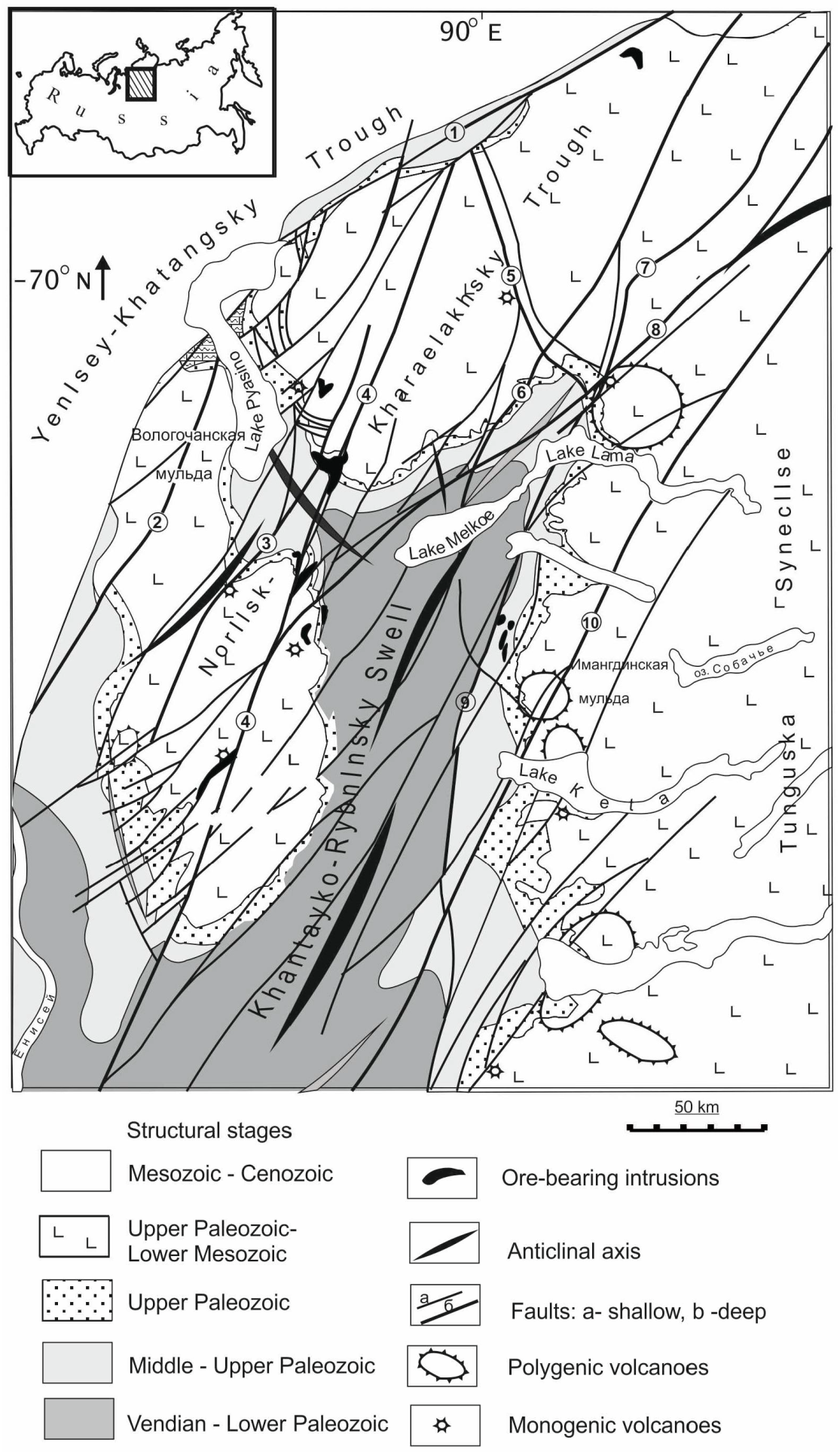

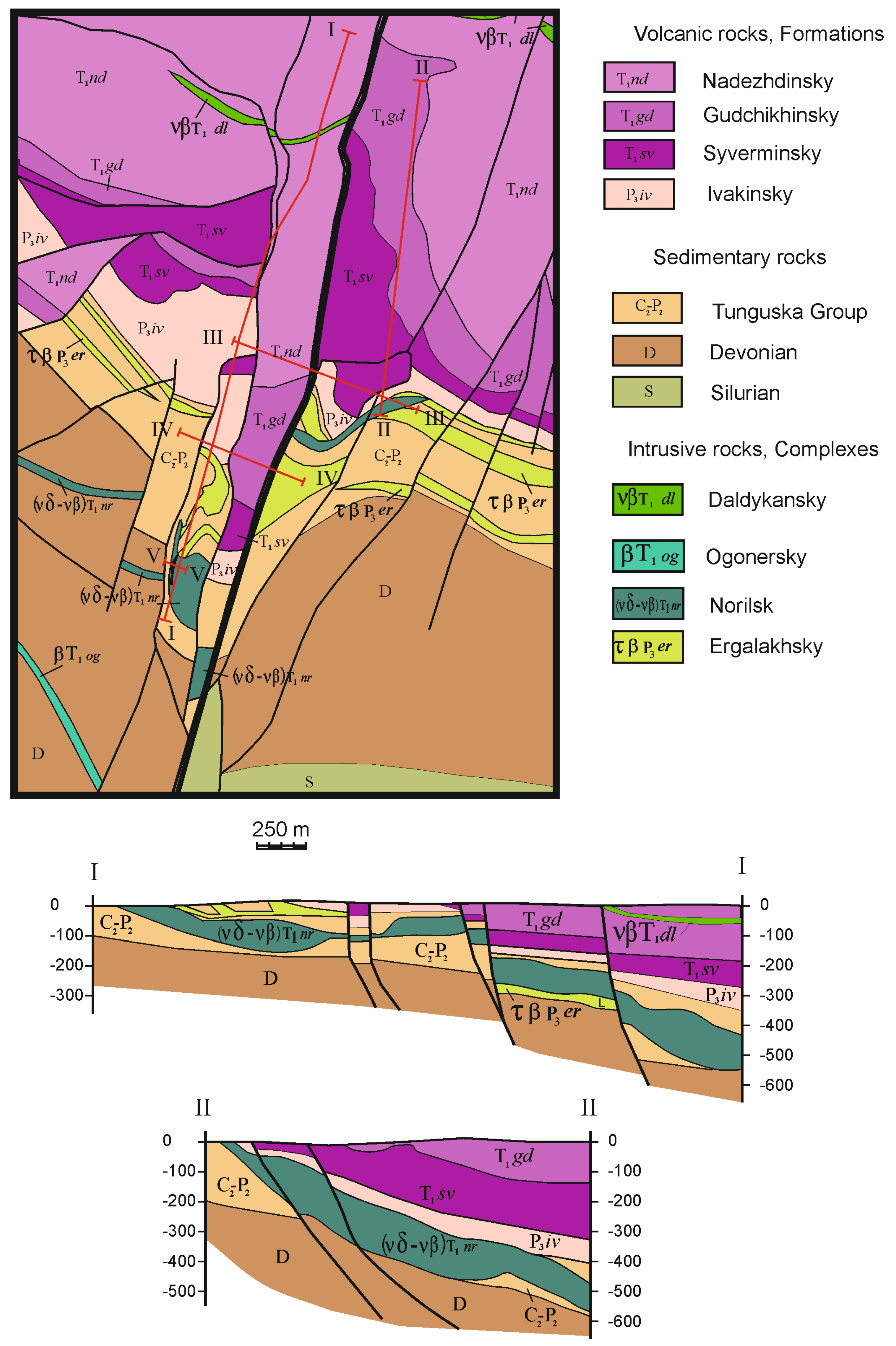

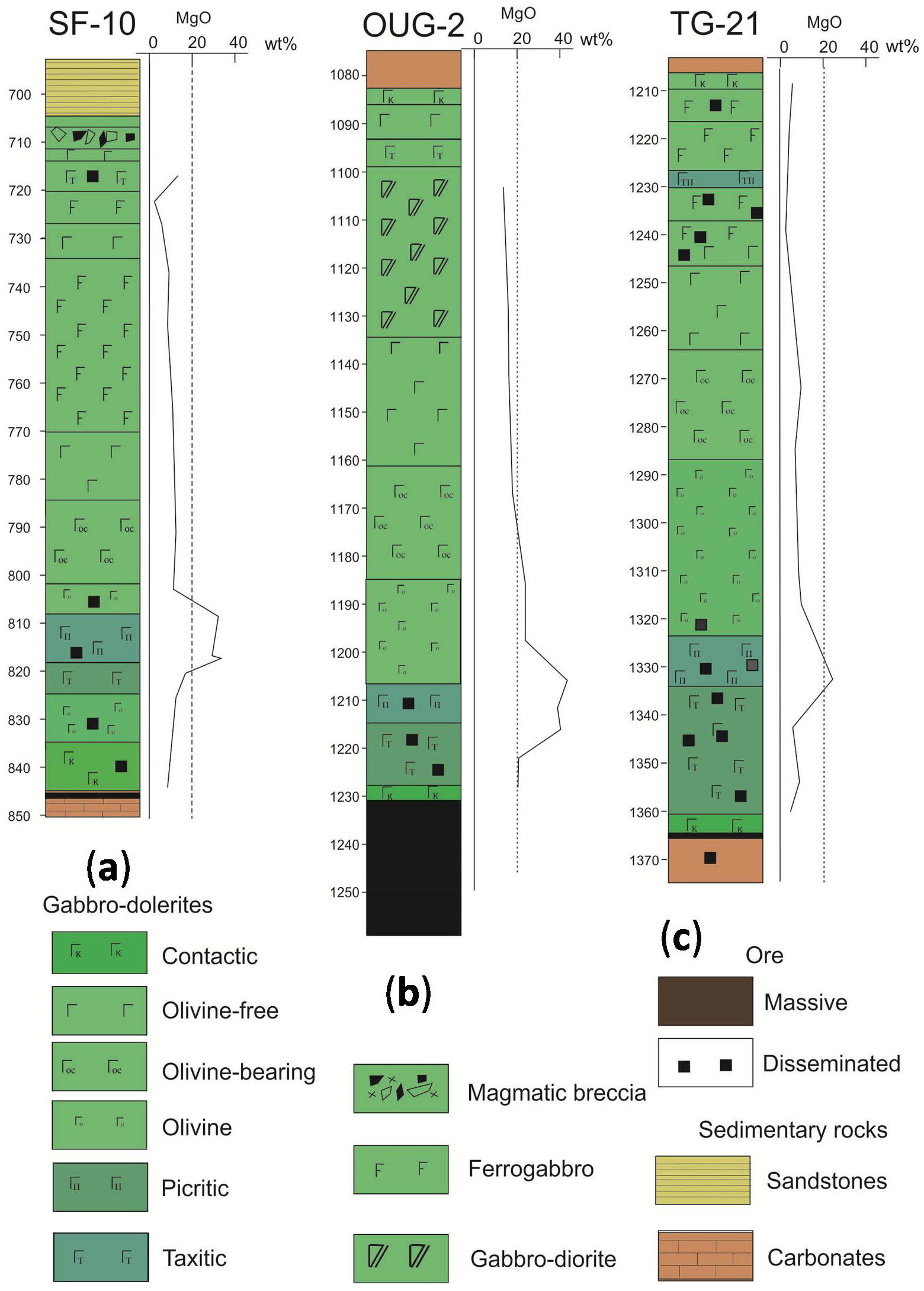
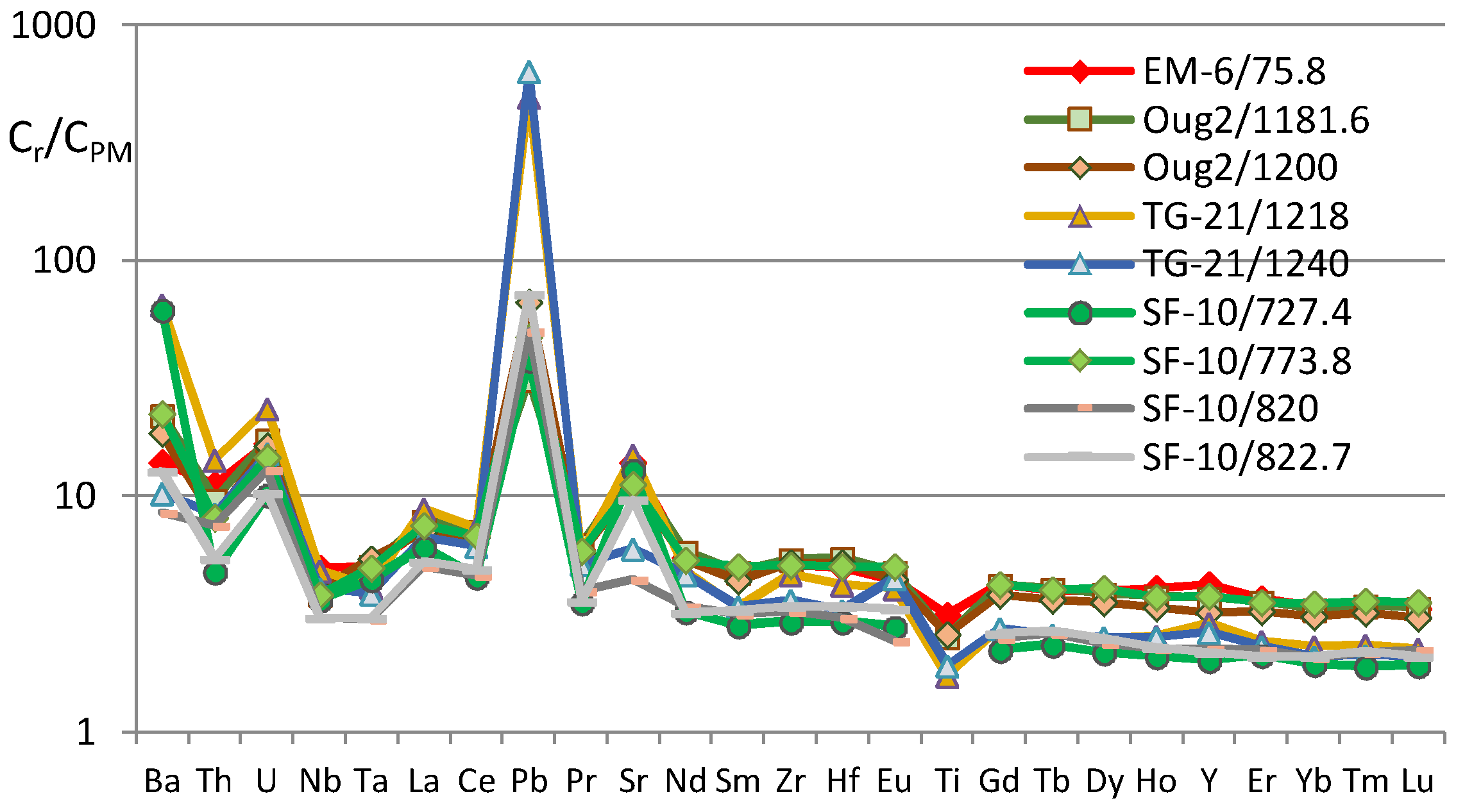
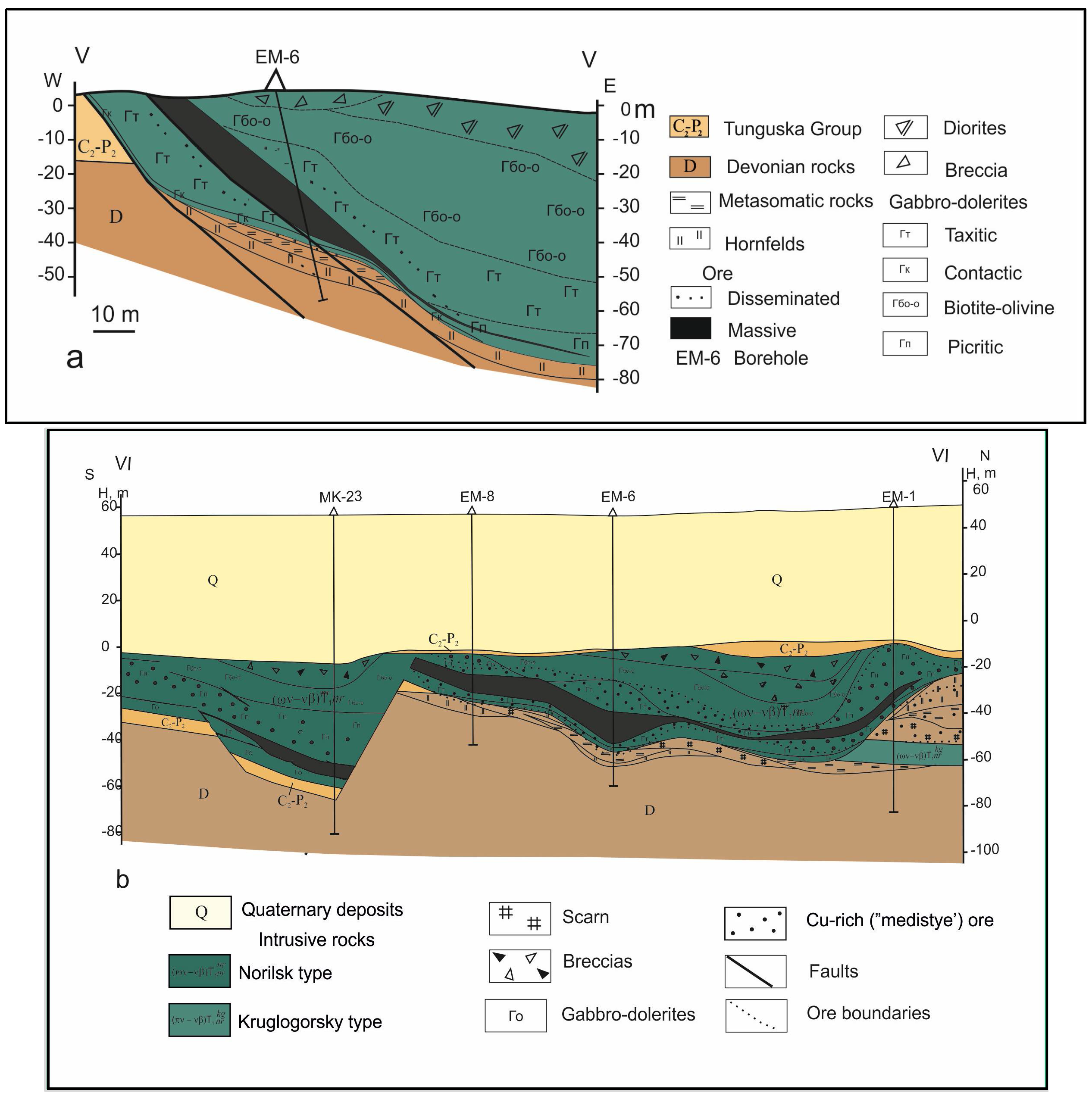
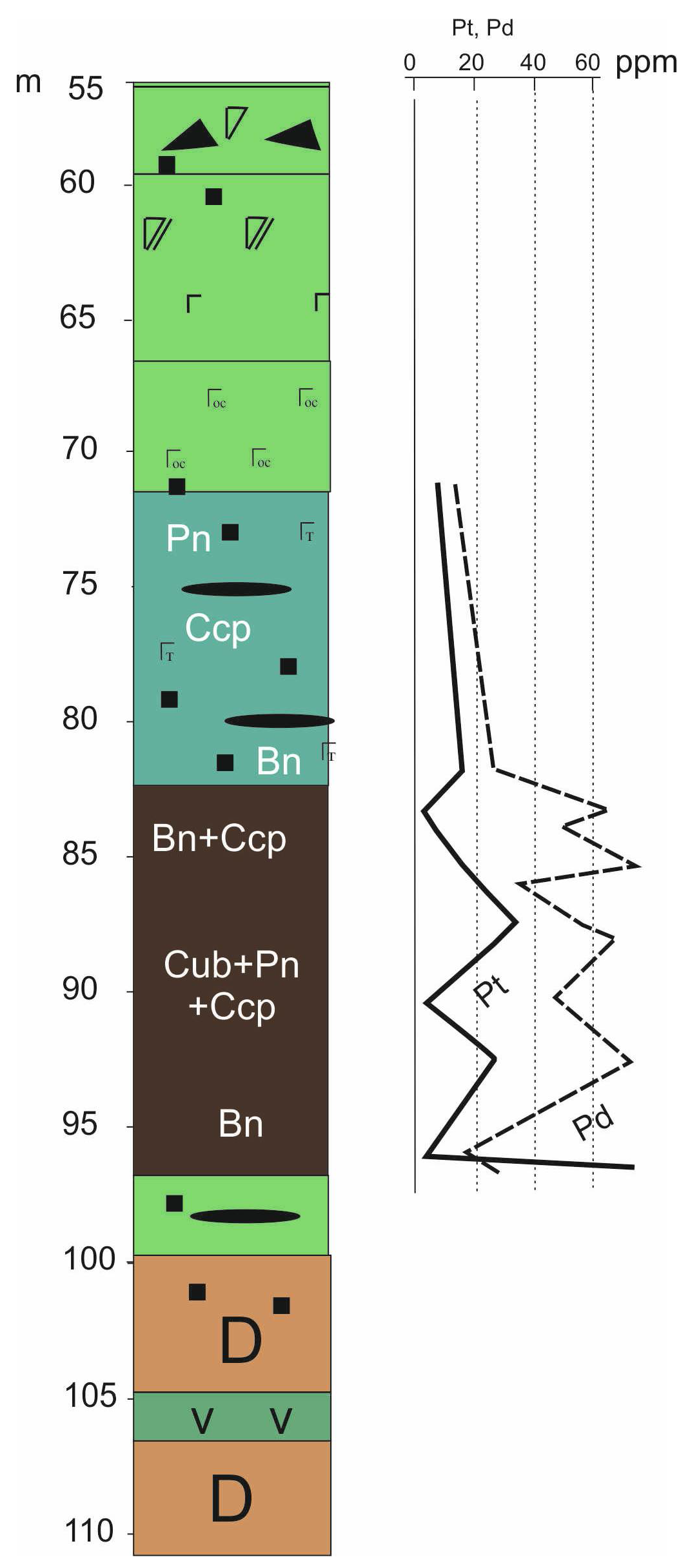

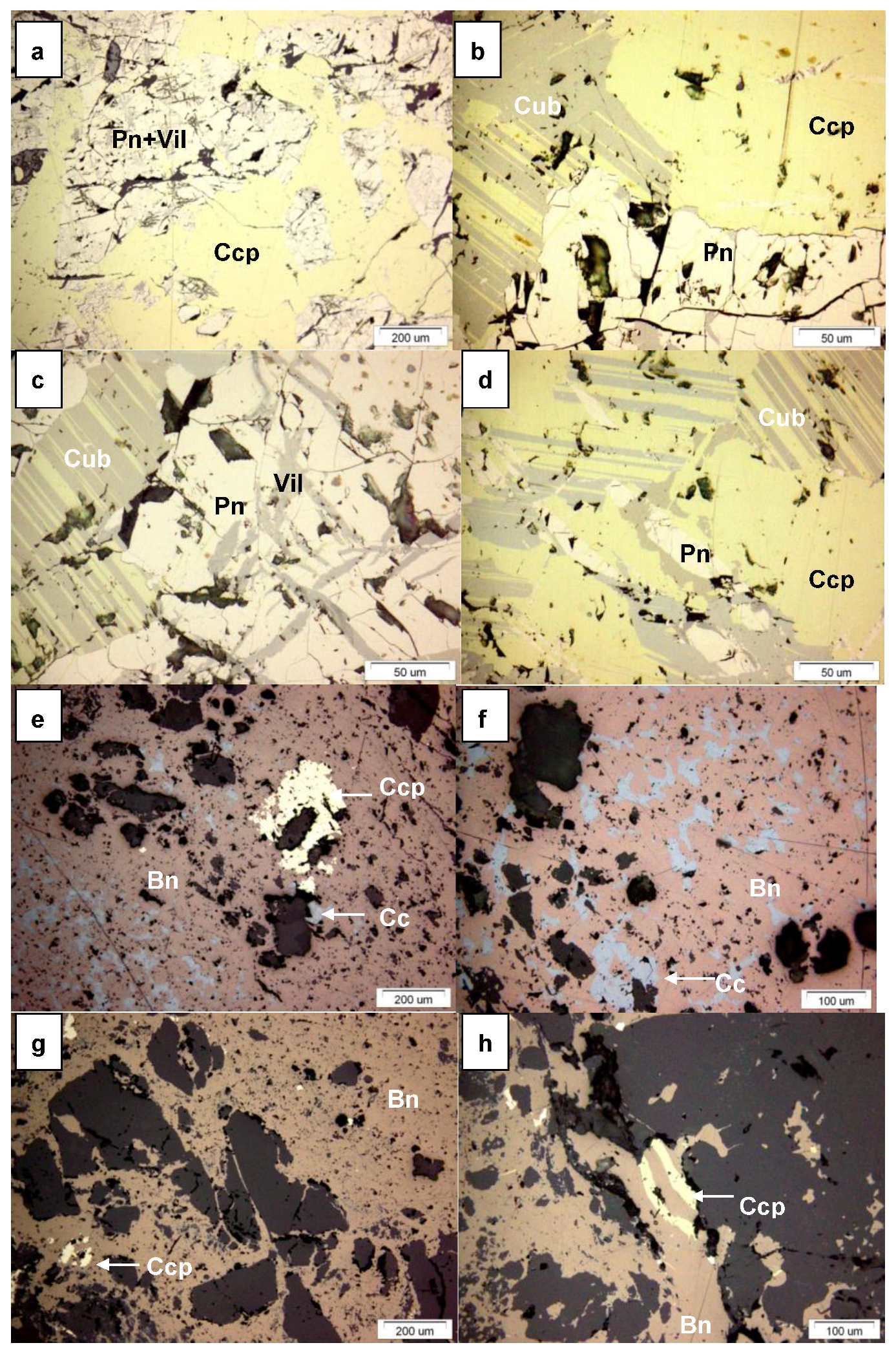
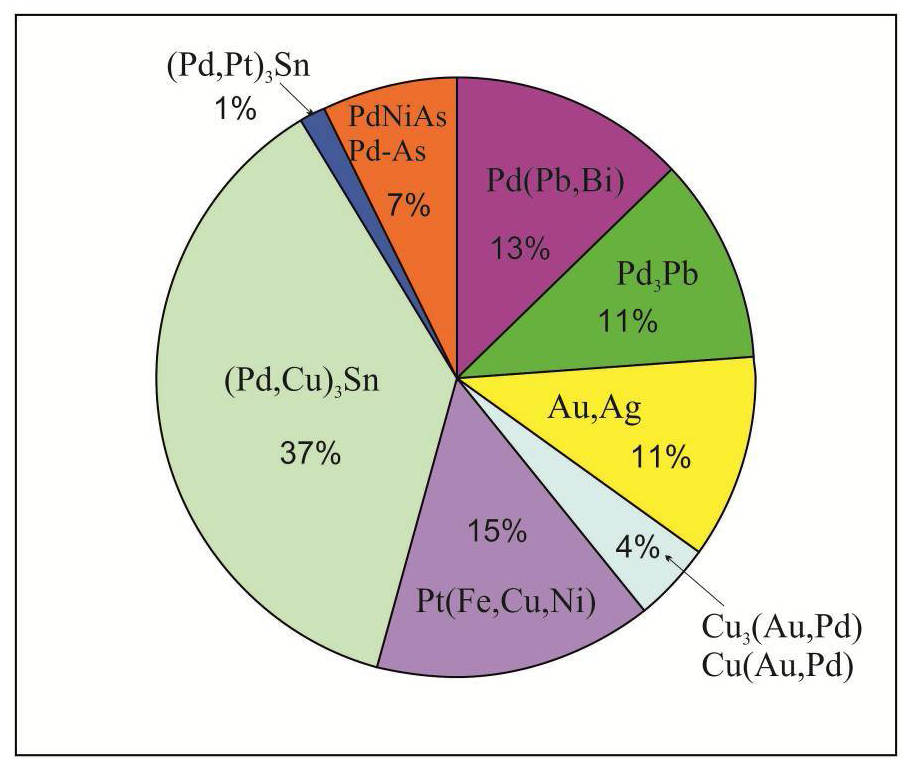

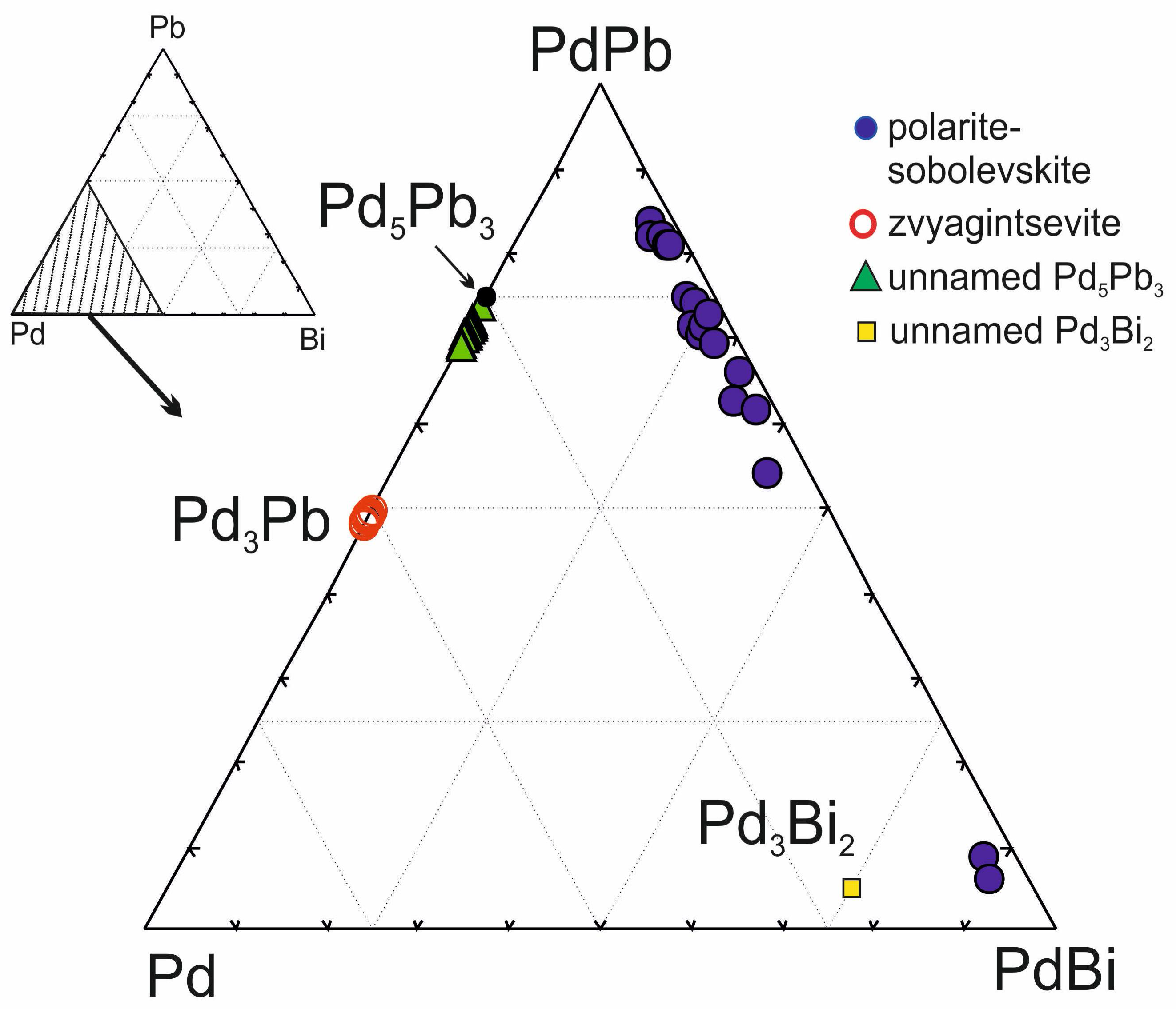

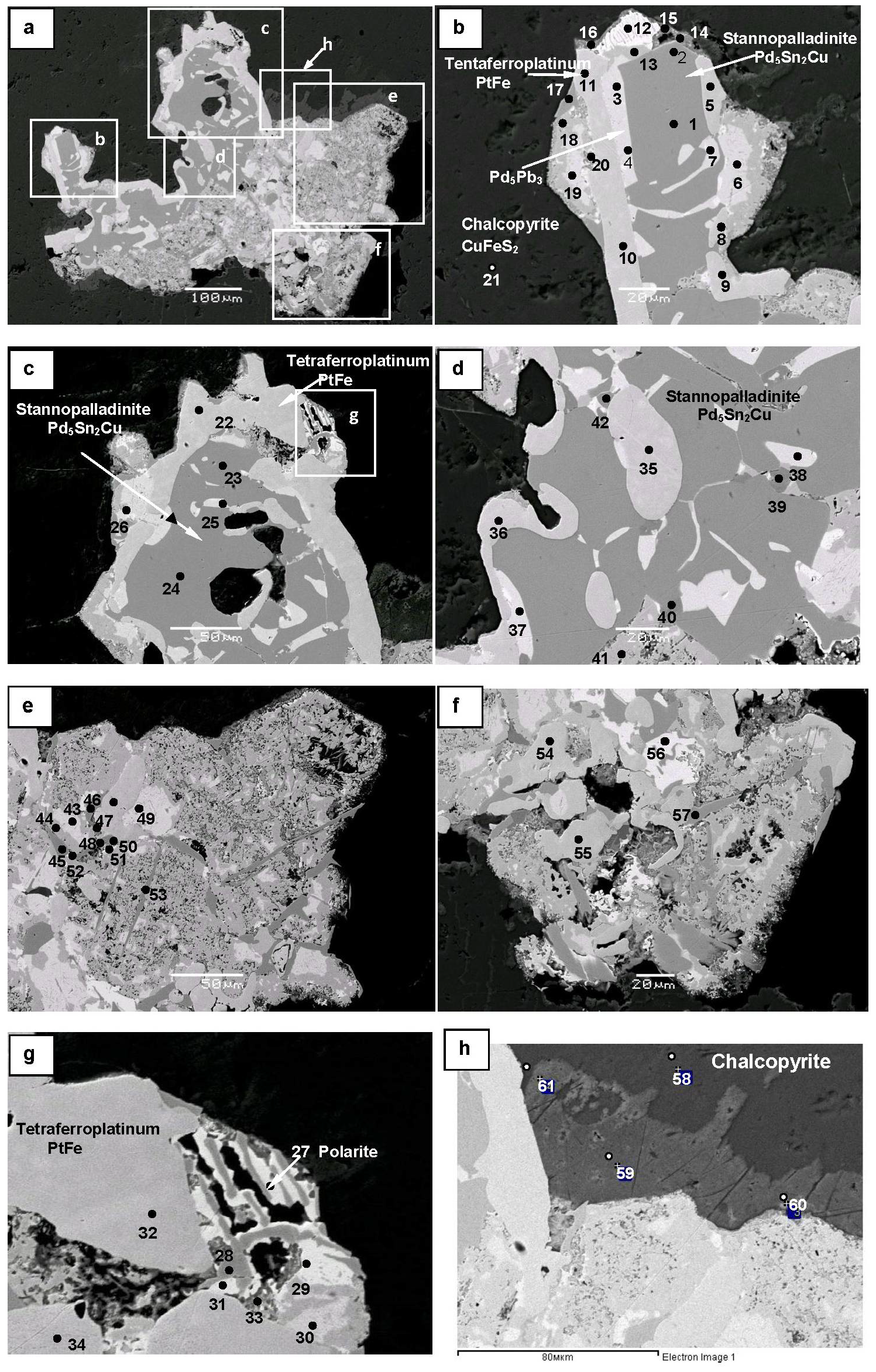
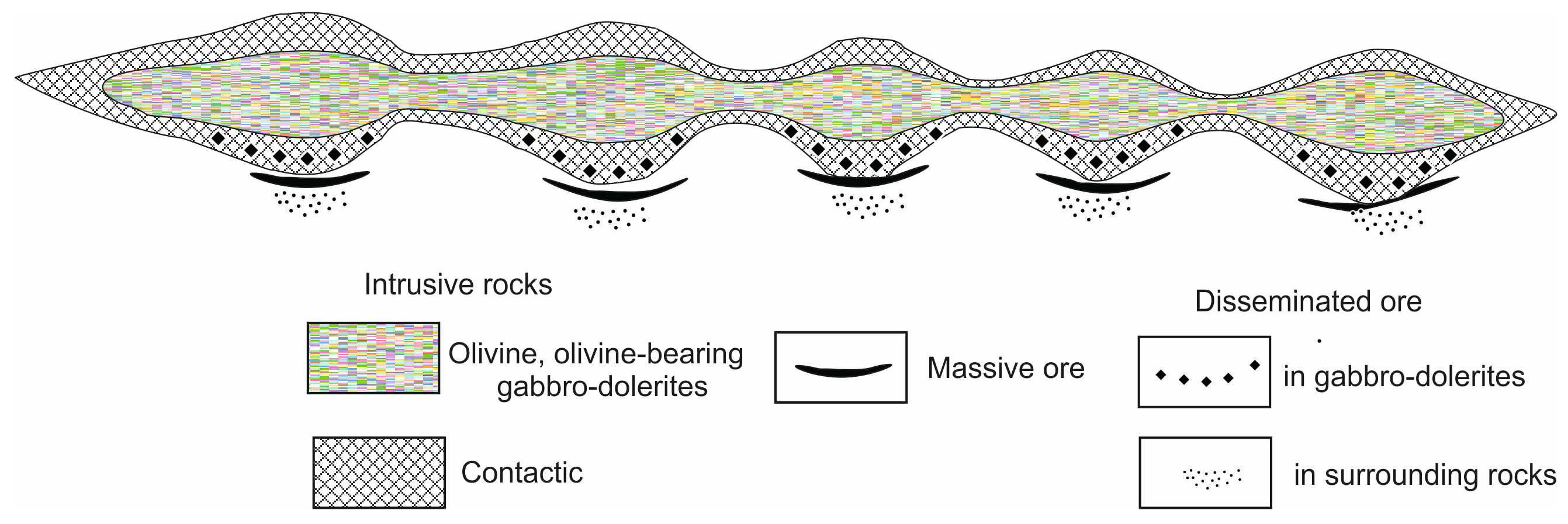
| No. | 1 | 2 | 3 | 4 | 5 | 6 | 7 | 8 | 9 | 10 |
|---|---|---|---|---|---|---|---|---|---|---|
| Depth, m | 727.4 | 730.2 | 731.1 | 732.5 | 737.8 | 746.5 | 756.6 | 759 | 761.5 | 773.8 |
| SiO2 | 43.7 | 49.9 | 50.9 | 57.8 | 49.4 | 50.4 | 49.5 | 48.3 | 49.3 | 48.7 |
| TiO2 | 0.46 | 1.37 | 1.71 | 1.20 | 1.63 | 1.01 | 1.16 | 1.09 | 1.02 | 0.90 |
| Al2O3 | 16.1 | 13.0 | 13.5 | 13.8 | 13.4 | 13.3 | 14.4 | 15.1 | 15.4 | 15.2 |
| FeO tot. | 10.3 | 11.8 | 12.6 | 8.7 | 12.3 | 10.1 | 11.5 | 10.3 | 10.5 | 9.3 |
| MnO | 0.14 | 0.14 | 0.14 | 0.09 | 0.16 | 0.20 | 0.21 | 0.19 | 0.19 | 0.16 |
| MgO | 12.0 | 6.6 | 4.2 | 2.3 | 5.9 | 7.8 | 6.8 | 7.4 | 7.6 | 9.1 |
| CaO | 8.3 | 10.6 | 9.9 | 6.0 | 11.0 | 11.5 | 10.5 | 11.3 | 11.3 | 12.6 |
| Na2O | 0.8 | 3.3 | 3.7 | 7.6 | 3.1 | 2.5 | 2.7 | 2.7 | 2.1 | 1.9 |
| K2O | 2.1 | 1.0 | 1.2 | 0.2 | 0.8 | 1.2 | 0.9 | 0.9 | 0.8 | 0.6 |
| P2O5 | 0.07 | 0.16 | 0.21 | 0.42 | 0.16 | 0.11 | 0.13 | 0.12 | 0.12 | 0.10 |
| Cr2O3 | 0.43 | 0.04 | 0.01 | 0.01 | 0.02 | 0.05 | 0.10 | 0.07 | 0.07 | 0.19 |
| LOI | 4.80 | 1.83 | 1.48 | 1.41 | 1.83 | 1.65 | 1.89 | 2.26 | 1.39 | 1.02 |
| S | 0.6 | 0.3 | 0.3 | 0.4 | 0.2 | 0.1 | 0.1 | 0.1 | 0.1 | 0.1 |
| Ni | 0.19 | 0.01 | 0.00 | 0.00 | 0.01 | 0.01 | 0.01 | 0.01 | 0.01 | 0.01 |
| Cu | 0.15 | 0.01 | 0.01 | 0.01 | 0.02 | 0.02 | 0.02 | 0.01 | 0.01 | 0.01 |
| No. | 11 | 12 | 13 | 14 | 15 | 16 | 17 | 18 | 19 | 20 |
| Depth, m | 796 | 801 | 807 | 812.3 | 819.5 | 820 | 822.7 | 826.8 | 832 | 844.8 |
| SiO2 | 48.3 | 47.9 | 48.4 | 37.0 | 38.4 | 35.7 | 40.0 | 47.6 | 46.1 | 56.3 |
| TiO2 | 0.84 | 0.85 | 0.91 | 0.41 | 0.35 | 0.48 | 0.45 | 0.41 | 0.79 | 0.47 |
| Al2O3 | 17.1 | 17.4 | 16.9 | 6.6 | 8.4 | 5.9 | 15.4 | 18.8 | 16.5 | 10.6 |
| FeO tot. | 8.9 | 10.4 | 10.2 | 14.1 | 13.9 | 14.3 | 11.4 | 8.8 | 13.0 | 4.1 |
| MnO | 0.14 | 0.16 | 0.16 | 0.19 | 0.20 | 0.19 | 0.11 | 0.13 | 0.17 | 0.10 |
| MgO | 9.6 | 8.4 | 8.0 | 27.1 | 24.1 | 28.0 | 12.5 | 8.3 | 7.5 | 4.3 |
| CaO | 11.4 | 11.0 | 11.2 | 4.9 | 6.1 | 4.4 | 8.1 | 12.1 | 10.6 | 16.5 |
| Na2O | 1.8 | 1.9 | 2.0 | 0.4 | 0.5 | 0.5 | 1.0 | 1.8 | 2.0 | 2.9 |
| K2O | 0.4 | 0.6 | 0.4 | 0.2 | 0.3 | 0.2 | 0.4 | 0.5 | 0.7 | 1.7 |
| P2O5 | 0.12 | 0.11 | 0.16 | 0.05 | 0.06 | 0.06 | 0.07 | 0.05 | 0.10 | 0.08 |
| Cr2O3 | 0.13 | 0.16 | 0.21 | 0.48 | 0.19 | 0.13 | 0.10 | 0.10 | 0.05 | 0.04 |
| LOI | 1.10 | 1.00 | 1.21 | 6.30 | 5.39 | 6.97 | 4.84 | 0.91 | 1.15 | 0.00 |
| S | 0.1 | 0.1 | 0.2 | 1.0 | 0.9 | 1.1 | 1.9 | 0.3 | 1.1 | 1.6 |
| Ni | 0.02 | 0.02 | 0.03 | 0.57 | 0.48 | 0.74 | 0.87 | 0.05 | 0.07 | 0.04 |
| Cu | 0.02 | 0.01 | 0.02 | 0.75 | 0.71 | 1.22 | 2.66 | 0.11 | 0.17 | 1.23 |
| No. | 21 | 22 | 23 | 24 | 25 | 26 | 27 | 28 | 29 | 30 |
| Depth, m | 65.2 | 75.8 | 80.2 | LOD | BCR-2 * | BCR-2 ** | DTS-2 * | DTS-2 ** | BHVO-1 * | BHVO-1 ** |
| SiO2 | 46.2 | 45.0 | 48.6 | 0.04 | 53.8 | 54.1 | 39.8 | 39.4 | 49.6 | 49.9 |
| TiO2 | 1.77 | 0.99 | 0.87 | 0.005 | 2.31 | 2.26 | 2.46 | 2.37 | ||
| Al2O3 | 15.7 | 15.4 | 15.4 | 0.020 | 13.8 | 13.5 | 0.42 | 0.45 | 13.7 | 13.5 |
| FeO tot. | 13.2 | 11.0 | 10.7 | 0.002 | 12.3 | 12.4 | 7.1 | 7.0 | 10.9 | 11.1 |
| MnO | 0.22 | 0.21 | 0.15 | 0.002 | 0.18 | 0.20 | 0.10 | 0.11 | 0.16 | 0.17 |
| MgO | 6.5 | 8.4 | 9.9 | 0.05 | 3.71 | 3.59 | 50.0 | 49.4 | 7.19 | 7.23 |
| CaO | 11.3 | 12.1 | 7.5 | 0.03 | 6.94 | 7.12 | 0.12 | 0.12 | 11.3 | 11.4 |
| Na2O | 1.6 | 2.3 | 2.1 | 0.02 | 3.24 | 3.16 | 2.31 | 2.22 | ||
| K2O | 0.6 | 1.1 | 2.1 | 0.007 | 1.71 | 1.79 | 0.54 | 0.52 | ||
| P2O5 | 0.12 | 0.02 | 0.12 | 0.004 | 0.31 | 0.35 | 0.29 | 0.27 | ||
| Cr2O3 | 0.02 | 0.06 | 0.01 | 0.005 | 0.22 | 0.23 | 0.04 | 0.04 | ||
| LOI | 2.11 | 2.48 | 2.63 | 0.005 | ||||||
| S | 0.6 | 0.3 | 0.7 | 0.02 | ||||||
| Ni | 0.11 | 0.01 | 0.21 | 0.0005 | 0.39 | 0.38 | 0.011 | 0.012 | ||
| Cu | 0.13 | 0.01 | 0.22 | 0.0006 | 0.013 | 0.013 |
| No. | 1 | 2 | 3 | 4 | 5 | 6 | 7 | 8 | 9 | 10 | 11 | 12 |
|---|---|---|---|---|---|---|---|---|---|---|---|---|
| N sample | 1181.6 | 1200 | 1218 | 1240 | 727.4 | 773.8 | 820 | 822.7 | 75.8 | LOD | BHVO-2 * | BHVO-2 ** |
| Be | 0.42 | 0.42 | 0.68 | 0.58 | 0.22 | 0.29 | 0.19 | 0.28 | 0.39 | 0.05 | 0.91 | 1.08 |
| Sc | 26 | 23 | 16 | 15 | 17 | 33 | 17 | 12 | 43 | 0.02 | 31.6 | 31.8 |
| V | 182 | 178 | 90 | 104 | 182 | 210 | 130 | 117 | 187 | 0.02 | 327 | 318 |
| Cr | 380 | 938 | 180 | 171 | 4740 | 464 | 367 | 248 | 780 | 0.18 | 287 | 287 |
| Co | 47 | 52 | 41 | 27 | 83 | 37 | 174 | 170 | 51 | 0.01 | 45.0 | 44.9 |
| Ni | 254 | 287 | 539 | 229 | 1870 | 112 | 4660 | 6000 | 210 | 0.16 | 121 | 120 |
| Cu | 134 | 91 | 893 | 708 | 1330 | 73 | 5330 | 9000 | 81 | 0.45 | 130 | 129 |
| Zn | 61 | 68 | 281 | 470 | 79 | 84 | 85 | 117 | 64 | 0.14 | 103 | 104 |
| Rb | 15 | 3.4 | 87 | 17 | 72 | 15 | 6.2 | 18 | 25 | 0.29 | 9.28 | 9.26 |
| Sr | 268 | 230 | 317 | 127 | 271 | 239 | 94 | 203 | 295 | 0.57 | 392 | 394 |
| Y | 17 | 15 | 13 | 12 | 9.2 | 17 | 10 | 9.9 | 19 | 0.003 | 24.7 | 25.9 |
| Zr | 61 | 59 | 52 | 41 | 33 | 57 | 36 | 38 | 58 | 0.14 | 171 | 171 |
| Nb | 2.8 | 2.8 | 3.5 | 2.9 | 2.6 | 2.7 | 2.2 | 2.2 | 3.5 | 0.15 | 18.0 | 18.1 |
| Cs | 0.74 | 0.47 | 0.96 | 0.29 | 1.9 | 0.71 | 0.23 | 1.3 | 0.49 | 0.14 | 0.10 | 0.10 |
| Ba | 154 | 130 | 456 | 72 | 430 | 156 | 60 | 89 | 97 | 0.33 | 0.13 | 131 |
| La | 5.4 | 4.9 | 6.1 | 4.6 | 4.2 | 5.2 | 3.4 | 3.6 | 5.0 | 0.01 | 15.2 | 15.2 |
| Ce | 13 | 12 | 13 | 11 | 8.0 | 12 | 8.2 | 8.8 | 12 | 0.01 | 37.5 | 37.5 |
| Pr | 1.7 | 1.6 | 1.6 | 1.4 | 0.98 | 1.6 | 1.1 | 0.99 | 1.6 | 0.001 | 5.27 | 5.34 |
| Nd | 7.9 | 7.3 | 6.5 | 6.3 | 4.4 | 7.3 | 4.7 | 4.3 | 7.5 | 0.004 | 24.0 | 24.3 |
| Sm | 2.1 | 1.9 | 1.5 | 1.5 | 1.3 | 2.2 | 1.4 | 1.5 | 2.1 | 0.005 | 6.07 | 6.02 |
| Eu | 0.80 | 0.75 | 0.69 | 0.76 | 0.47 | 0.84 | 0.41 | 0.56 | 0.74 | 0.002 | 2.03 | 2.04 |
| Gd | 2.5 | 2.3 | 1.7 | 1.6 | 1.3 | 2.5 | 1.5 | 1.6 | 2.5 | 0.005 | 6.00 | 6.21 |
| Tb | 0.44 | 0.39 | 0.28 | 0.28 | 0.25 | 0.44 | 0.28 | 0.29 | 0.43 | 0.01 | 0.96 | 0.94 |
| Dy | 2.8 | 2.6 | 1.8 | 1.9 | 1.6 | 3.0 | 1.8 | 1.8 | 2.9 | 0.005 | 5.24 | 5.28 |
| Ho | 0.62 | 0.55 | 0.42 | 0.41 | 0.34 | 0.61 | 0.37 | 0.37 | 0.67 | 0.003 | 0.97 | 0.99 |
| Er | 1.7 | 1.6 | 1.2 | 1.1 | 1.0 | 1.7 | 1.1 | 1.0 | 1.8 | 0.001 | 2.38 | 2.51 |
| Tm | 0.26 | 0.24 | 0.17 | 0.16 | 0.14 | 0.27 | 0.16 | 0.16 | 0.26 | 0.02 | 0.33 | 0.33 |
| Yb | 1.6 | 1.5 | 1.1 | 1.0 | 1.0 | 1.7 | 1.0 | 1.0 | 1.7 | 0.004 | 1.95 | 1.99 |
| Lu | 0.25 | 0.23 | 0.17 | 0.16 | 0.14 | 0.26 | 0.17 | 0.16 | 0.25 | 0.001 | 0.28 | 0.28 |
| Hf | 1.7 | 1.6 | 1.3 | 1.0 | 0.90 | 1.6 | 0.95 | 1.1 | 1.5 | 0.06 | 4.53 | 4.47 |
| Ta | 0.21 | 0.22 | 0.17 | 0.16 | 0.18 | 0.20 | 0.12 | 0.12 | 0.21 | 0.07 | 1.18 | 1.15 |
| W | 0.15 | 0.38 | 0.86 | 0.78 | 0.29 | 0.26 | 0.08 | 0.08 | 0.61 | 0.04 | 0.18 | 0.25 |
| Tl | 0.08 | 0.05 | 0.33 | 0.06 | 0.65 | 0.08 | 0.07 | 0.24 | 0.12 | 0.001 | 0.03 | 0.02 |
| Pb | 2.2 | 4.8 | 35 | 45 | 2.7 | 3.4 | 3.6 | 5.1 | 2.4 | 0.09 | 1.53 | 1.65 |
| Bi | 0.03 | 0.03 | 0.15 | 0.16 | 0.11 | 0.03 | 0.18 | 0.47 | 0.04 | 0.01 | 0.02 | 0.01 |
| Th | 0.82 | 0.69 | 1.2 | 0.71 | 0.41 | 0.69 | 0.64 | 0.46 | 0.95 | 0.03 | 1.28 | 1.22 |
| U | 0.37 | 0.35 | 0.50 | 0.32 | 0.21 | 0.31 | 0.27 | 0.22 | 0.35 | 0.001 | 0.412 | 0.41 |
| No. | 1 | 2 | 3 | 4 | 5 | 6 | 7 | 8 | 9 |
|---|---|---|---|---|---|---|---|---|---|
| Sample | MA-12a | MA-13a | Ma-14a | MA-15a | MA-16a | MA-17a | EM-6/71.0 | EM-6/81.0 | EM-6/83.3 |
| Cu | 23.33 | 23.02 | 25.28 | 20.50 | 20.36 | 24.70 | 2.78 | 3.93 | 24.44 |
| Ni | 3.93 | 5.64 | 2.95 | 3.88 | 3.86 | 4.35 | 0.58 | 0.77 | 1.67 |
| Co | 0.06 | 0.10 | 0.05 | 0.06 | 0.06 | 0.07 | 0.017 | 0.01 | 0.02 |
| Fe | 22.96 | 22.42 | 23.08 | 25.88 | 27.93 | 23.78 | 15.32 | 16.70 | 25.82 |
| S | 50.20 | 48.30 | 51.50 | 50.30 | 49.30 | 49.40 | 3.19 | 4.53 | 47.20 |
| As | 0.94 | 1.51 | 1.50 | 2.75 | 1.20 | 2.56 | 1.09 | ||
| Se | 124 | 133 | 121 | 152 | 124 | 121 | 7.2 | 10.2 | 153 |
| Ag | 37.6 | 38.1 | 38.4 | 63.5 | 81.3 | 47.8 | 10.2 | 21.7 | 49.3 |
| Au | 0.9 | 1.26 | 2.67 | 10.1 | 0.4 | 8.3 | 0.85 | 2.44 | 1.16 |
| Pt | 2.6 | 1.5 | 9.6 | 124 | 2.5 | 5.4 | 3.31 | 8.86 | 0.9 |
| Pd | 36.5 | 48 | 47.5 | 155 | 115 | 97.5 | 10.6 | 22.6 | 66.5 |
| Rh | 1.32 | 1.24 | 0.95 | 1.28 | 0.92 | 0.88 | 0.12 | 0.38 | 0.78 |
| Ir | 0.09 | 0.09 | 0.10 | 0.10 | 0.10 | 0.09 | 0.10 | ||
| Ru | 0.09 | 0.08 | 0.06 | 0.08 | 0.07 | 0.06 | 0.05 | ||
| Pb | 215 | 211 | 220 | 297 | 248 | 253 | 12.80 | 16.20 | 237 |
| Zn | 61 | 50 | 61 | 609 | 586 | 56 | 7.80 | 8.32 | 696 |
| Sn | 8.51 | 7.78 | 12.85 | 58.76 | 14.42 | 13.72 | 8.56 | ||
| Te | 24.42 | 26.98 | 30.49 | 37.89 | 28.29 | 25.91 | 38.95 | ||
| Mn | 18.9 | 16 | 16.2 | 33.6 | 81.4 | 19.9 | 64 | ||
| Mo | 10.03 | 13.31 | 6.71 | 7.65 | 8.69 | 10.26 | 3.54 | ||
| Sr | 4.47 | 4.98 | 4.84 | 6.31 | 6.22 | 4.36 | 7.08 | ||
| P | 308 | 292 | 313 | 300 | 301 | 291 | 327 | ||
| Ba | 2.8 | 2.5 | 2.3 | 5.0 | 4.9 | 2.5 | 3.7 | ||
| No. | 10 | 11 | 12 | 13 | 14 | 15 | 16 | 17 | |
| Sample | EM-6/84.7 | EM-6/85.5 | EM-6/86.2 | EM-6/87.8 | EM-6/88.5 | EM-6/90.8 | EM-6/93 | EM-6/95 | |
| Cu | 19.03 | 21.87 | 24.28 | 20.52 | 24.17 | 21.95 | 23.30 | 11.00 | |
| Ni | 4.83 | 3.84 | 3.30 | 5.36 | 3.72 | 3.16 | 4.92 | 3.44 | |
| Co | 0.08 | 0.06 | 0.05 | 0.09 | 0.06 | 0.05 | 0.08 | 0.09 | |
| Fe | 25.53 | 26.17 | 25.99 | 24.36 | 23.65 | 24.87 | 25.06 | 36.47 | |
| S | 50.00 | 49.00 | 45.80 | 45.20 | 48.40 | 49.20 | 45.80 | 51.30 | |
| As | 0.71 | 0.97 | 1.08 | 1.34 | 1.04 | 0.78 | 0.35 | ||
| Se | 126 | 129 | 132 | 113 | 129 | 119 | 137 | 73 | |
| Ag | 58.2 | 35.4 | 72.2 | 51.4 | 39.7 | 52.6 | 70.3 | 10.56 | |
| Au | 0.37 | 1.51 | 0.28 | 1.33 | 6.98 | 0.85 | 2.35 | 0.21 | |
| Pt | 2.9 | 8.3 | 20.6 | 28.9 | 22 | 2.3 | 25.1 | 1.4 | |
| Pd | 43.7 | 75.85 | 32.5 | 58.3 | 70 | 45 | 75 | 14.5 | |
| Rh | 0.91 | 0.83 | 1.12 | 1.01 | 0.94 | 0.88 | 0.88 | 0.51 | |
| Ir | 0.09 | 0.11 | 0.10 | 0.10 | 0.09 | 0.09 | 0.10 | 0.10 | |
| Ru | 0.07 | 0.07 | 0.11 | 0.06 | 0.06 | 0.06 | 0.07 | 0.07 | |
| No | 10 | 11 | 12 | 13 | 14 | 15 | 16 | 17 | |
| Pb | 199 | 211 | 209 | 266 | 232 | 224 | 203 | 127 | |
| Zn | 558 | 590 | 470 | 470 | 568 | 543 | 550 | 103 | |
| Sn | 8.18 | 8.91 | 7.91 | 16.43 | 14.38 | 11.26 | 27.07 | 8.53 | |
| Te | 21.82 | 23.57 | 24.21 | 26.38 | 22.58 | 23.73 | 23.09 | 13.21 | |
| Mn | 143.6 | 37.9 | 55.8 | 41.8 | 48.6 | 38.55 | 15.9 | 11.67 | |
| Mo | 10.65 | 9.19 | 11.77 | 7.54 | 8.99 | 6.93 | 11.12 | 6.57 | |
| Sr | 13.58 | 8.62 | 8.54 | 16.96 | 8.78 | 11.26 | 5.22 | 3.81 | |
| P | 310 | 360 | 292 | 304 | 306 | 316 | 317 | 323 | |
| Ba | 3.1 | 3.5 | 3.2 | 3.3 | 5.4 | 4.3 | 3.2 | 2.3 | |
| No. | 18 | 19 | 20 | 21 | 22 | 23 | 24 | 25 | |
| Sample | EM-6/96.4 | ТG-21/1316.4 | ТG-21/1333.6 | ТG-21/1361.9 | ТG-21/1362 | N2/4a | N2/2 | N2/4 | |
| Cu | 20.04 | 0.01 | 0.59 | 1.74 | 2.25 | 1.75 | 0.87 | 2.18 | |
| Ni | 6.17 | 0.02 | 0.35 | 3.07 | 3.27 | 2.01 | 0.52 | 2.34 | |
| Co | 0.11 | 0.01 | 0.02 | 0.13 | 0.13 | 0.10 | 0.02 | 0.11 | |
| Fe | 24.68 | 7.43 | 12.61 | 34.16 | 31.40 | 30.05 | 10.78 | 36.17 | |
| S | 48.40 | 0.05 | 1.99 | 34.96 | 33.50 | 24.68 | 6.66 | 40.33 | |
| As | 0.42 | 3.41 | 3.12 | 1.91 | 1.48 | 0.60 | 3.34 | 0.32 | |
| Se | 82 | 6 | 10 | 19 | 56 | 45 | 21 | 21 | |
| Ag | 12.3 | 1.05 | 2.42 | 7.96 | 2.95 | 5.31 | 2.89 | 2.81 | |
| Au | 0.97 | 0.01 | 0.01 | 0.01 | 0.01 | 0.04 | 0.18 | 0.03 | |
| Pt | 78 | 1.93 | 0.31 | 1.64 | 0.35 | 0.19 | 2.52 | 0.07 | |
| Pd | 27.7 | 0.06 | 2.40 | 0.67 | 4.06 | 4.21 | 5.85 | 4.45 | |
| Rh | 1.02 | 0.15 | 3.50 | 3.35 | 1.31 | 3.10 | |||
| Ir | 0.16 | ||||||||
| Ru | 0.11 | ||||||||
| Pb | 209 | 17 | 34 | 23 | 17 | 26 | 34 | 13 | |
| Zn | 59 | 66 | 590 | 45 | 32 | 66 | 47 | 61 | |
| Sn | 12.66 | ||||||||
| Te | 3.71 | 0.03 | 0.09 | 0.34 | 0.44 | 1.29 | 1.08 | 2.36 | |
| Mn | 42.3 | 970 | 1400 | 290 | 510 | 670 | 720 | 790 | |
| Mo | 13.81 | ||||||||
| Sr | 5.02 | 248.00 | 156.00 | 61.30 | 88.20 | 162.00 | 254.00 | 143.00 | |
| P | 302 | 560 | 380 | 490 | 660 | 660 | 480 | 540 | |
| Ba | 2.9 | 128.4 | 63.2 | 19.1 | 24.9 | 27.7 | 130.4 | 13.1 |
| Main | Major | Rare (PGM) |
|---|---|---|
| Chalcopyrite CuFeS2 | Bornite Cu5FeS4 | Majakite PdNiAs |
| Pentlandite (Ni,Fe,Co)9S8 | Chalcocite Cu2S | Palladoarsenide Pd2As |
| Cubanite CuFe2S3 | Pyrite FeS2 | Stillwaterite (Pd,Ni)8As3 |
| Pyrrhotite Fe1-xS | Magnetite FeFe2O4 Violarite FeNi2S4 Sphalerite ZnS Galena PbS | Zvyagintsevite Pd3Pb Plumbopalladinite Pd3Pb2 Polarite Pd(Pb,Bi) |
| Rustenburgite (Pt,Pd)3Sn Atokite (Pd,Pt)3Sn Taimyrite (Pd,Cu,Pt)3Sn Stannopalladinite Pd5Sn2Cu Auricupride Cu3(Au,Pd) Tetra-auricupride Cu(Au,Pd) Cu-Au-Ag alloys Guanglinite Pd3As Sobolevskite PdBi |
| No. | Cu | Co | Ni | Fe | S | Total | Mineral |
|---|---|---|---|---|---|---|---|
| 1 | 35.32 | 0.09 | 0.00 | 30.99 | 35.30 | 101.70 | Chalcopyrite |
| 2 | 34.52 | 0.10 | 0.01 | 31.10 | 34.95 | 100.68 | Chalcopyrite |
| 3 | 35.08 | 0.00 | 0.05 | 31.35 | 35.33 | 101.81 | Chalcopyrite |
| 4 | 34.35 | 0.00 | 0.04 | 31.01 | 35.05 | 100.45 | Chalcopyrite |
| 5 | 0.10 | 0.37 | 33.97 | 32.13 | 33.87 | 100.44 | Pentlandite |
| 6 | 1.44 | 0.52 | 31.33 | 31.27 | 35.00 | 99.56 | Pentlandite |
| 7 | 0.09 | 0.50 | 33.58 | 32.54 | 34.14 | 100.85 | Pentlandite |
| 8 | 0.72 | 0.47 | 33.98 | 32.10 | 33.49 | 100.76 | Pentlandite |
| 9 | 0.05 | 0.49 | 34.24 | 32.48 | 33.41 | 100.67 | Pentlandite |
| 10 | 0.75 | 0.66 | 32.29 | 29.91 | 34.80 | 98.41 | Pentlandite |
| 11 | 0.14 | 0.42 | 34.92 | 31.44 | 34.00 | 100.92 | Pentlandite |
| 12 | 0.30 | 0.63 | 34.70 | 30.86 | 33.65 | 100.14 | Pentlandite |
| 13 | 0.05 | 0.47 | 35.26 | 31.12 | 33.80 | 100.70 | Pentlandite |
| 14 | 0.05 | 0.45 | 33.91 | 30.23 | 34.48 | 99.12 | Pentlandite |
| 15 | 0.38 | 0.73 | 39.71 | 26.23 | 33.73 | 100.78 | Pentlandite |
| 16 | 1.34 | 0.19 | 27.67 | 36.71 | 33.63 | 99.54 | Pentlandite |
| 17 | 3.09 | 0.38 | 29.06 | 33.00 | 34.39 | 99.92 | Pentlandite |
| 18 | 3.42 | 0.43 | 36.07 | 26.85 | 33.51 | 100.28 | Pentlandite |
| 19 | 0.11 | 0.26 | 3.99 | 56.19 | 39.08 | 99.63 | Pyrrhotite |
| 20 | 0.12 | 0.47 | 7.53 | 55.56 | 36.91 | 100.59 | Pyrrhotite |
| 21 | 23.46 | 0.05 | 0.34 | 41.85 | 35.73 | 101.43 | Cubanite |
| 22 | 23.41 | 0.01 | 0.01 | 41.71 | 35.45 | 100.59 | Cubanite |
| 23 | 23.24 | 0.00 | 0.14 | 41.92 | 35.24 | 100.54 | Cubanite |
| 24 | 24.34 | 0.08 | 0.06 | 42.00 | 35.71 | 102.19 | Cubanite |
| 25 | 22.72 | 0.06 | 0.08 | 41.64 | 35.20 | 99.70 | Cubanite |
| 26 | 23.82 | 0.04 | 0.03 | 41.51 | 35.33 | 100.73 | Cubanite |
| 27 | 0.73 | 1.94 | 60.22 | 0.03 | 35.16 | 98.08 | Millerite |
| 28 | 1.01 | 1.43 | 60.91 | 0.03 | 35.49 | 98.87 | Millerite |
| 29 | 1.37 | 0.29 | 61.37 | 0.03 | 35.37 | 98.43 | Millerite |
| 30 | 1.55 | 0.27 | 62.04 | 0.09 | 35.17 | 99.12 | Millerite |
| 31 | 4.47 | 0.84 | 57.73 | 1.51 | 35.00 | 99.55 | Millerite |
| 32 | 79.18 | 0.07 | 0.00 | 0.56 | 21.54 | 101.35 | Chalcocite |
| 33 | 79.06 | 0.03 | 0.00 | 0.12 | 21.49 | 100.70 | Chalcocite |
| 34 | 79.59 | 0.00 | 0.00 | 0.06 | 21.07 | 100.72 | Chalcocite |
| 35 | 79.61 | 0.00 | 0.00 | 0.58 | 21.00 | 101.19 | Chalcocite |
| 36 | 60.23 | 0.01 | 0.08 | 13.74 | 25.32 | 99.38 | Bornite |
| 37 | 61.25 | 0.00 | 0.18 | 11.56 | 25.98 | 98.97 | Bornite |
| 38 | 63.22 | 0.00 | 0.00 | 11.05 | 25.56 | 99.83 | Bornite |
| 39 | 49.05 | 0.09 | 0.16 | 20.13 | 29.63 | 99.06 | Idaite |
| 40 | 8.98 | 0.44 | 26.22 | 30.01 | 34.44 | 100.09 | mss |
| 41 | 19.85 | 0.11 | 14.18 | 30.71 | 34.85 | 99.70 | mss |
| No. | Ni | Cu | Pt | Pd | Sn | Pb | Bi | Sb | As |
|---|---|---|---|---|---|---|---|---|---|
| 1 | 7.62 | 1.32 | 62.17 | 21.41 | 1.02 | 0.76 | 5.82 | ||
| 2 | 7.39 | 1.28 | 64.21 | 21.08 | 1.49 | 0.65 | 5.64 | ||
| 3 | 7.77 | 1.16 | 63.83 | 21.79 | 0.78 | 4.7 | |||
| 4 | 6.6 | 0.86 | 60.6 | 12.36 | 18.48 | 2.07 | |||
| 5 | 6.74 | 0.96 | 60.15 | 14.27 | 17.03 | 1.26 | |||
| 6 | 9.15 | 1.33 | 61.44 | 22.23 | 1.54 | 4.03 | |||
| 7 | 8.75 | 1.41 | 61.59 | 21.86 | 1.62 | 4.71 | |||
| 8 | 8.41 | 0.9 | 62.98 | 25.04 | 0.97 | 2.33 | |||
| 9 | 8.94 | 1.54 | 60.9 | 23.16 | 2.73 | 0.54 | 2.44 | ||
| 10 | 9.19 | 3.75 | 59.97 | 26.13 | |||||
| 11 | 9.42 | 1.9 | 61.32 | 25.62 | 1.72 | ||||
| 12 | 9.53 | 3.39 | 59.46 | 25.94 | 1.05 | 1.32 | 0.28 | ||
| 13 | 8.59 | 2.08 | 58.07 | 19.98 | 9.83 | 0.65 | 0.26 | ||
| 14 | 9.28 | 2.35 | 58.53 | 20.79 | 8.86 | 1.04 | |||
| 15 | 8.68 | 1.31 | 58.46 | 16.99 | 13.68 | 0.87 | |||
| 16 | 1.65 | 1.13 | 63.09 | 14.59 | 17.92 | ||||
| 17 | 1.92 | 2.03 | 62.99 | 14.05 | 17.92 | ||||
| 18 | 0.36 | 9.25 | 26.15 | 39.56 | 22.85 | ||||
| 19 | 0.27 | 1.53 | 30.87 | 44.25 | 22.05 |
| No. | Ag | Pd | Pb | Bi | Total | Formula |
|---|---|---|---|---|---|---|
| 1 | 60.48 | 38.69 | 99.17 | Pd3.01Pb0.99 | ||
| 2 | 61.45 | 38.95 | 100.4 | Pd3.02Pb0.98 | ||
| 3 | 61.69 | 38.56 | 100.25 | Pd3.03Pb0.97 | ||
| 4 | 61.57 | 38.18 | 99.75 | Pd3.03Pb0.97 | ||
| 5 | 45.34 | 51.9 | 97.24 | Pd5.04Pb2.96 | ||
| 6 | 3.44 | 43.12 | 51.11 | 97.67 | (Pd2.96Ag0.23)3.19Pb1.80 | |
| 7 | 3.09 | 45.28 | 52.85 | 101.22 | (Pd3.00Ag0.20)3.20Pb1.80 | |
| 8 | 3.37 | 44.75 | 52.44 | 100.56 | (Pd2.98Ag0.22)3.20Pb1.80 | |
| 9 | 3.27 | 44.93 | 52.44 | 100.64 | (Pd2.99Ag0.21)3.20Pb1.79 | |
| 10 | 35.38 | 54.86 | 9.75 | 99.99 | Pd1.03(Pb0.82Bi0.15)0.97 | |
| 11 | 35.06 | 53.99 | 11.28 | 100.33 | Pd1.02(Pb0.81Bi0.17)0.98 | |
| 12 | 35.31 | 49.83 | 14.72 | 99.86 | Pd1.03(Pb0.75Bi0.22)0.97 | |
| 13 | 35.71 | 47.69 | 16.25 | 99.65 | Pd1.04(Pb0.72Bi0.24)0.96 | |
| 14 | 34.47 | 43.53 | 21.57 | 99.57 | Pd1.02(Pb0.66Bi0.32)0.98 | |
| 15 | 35 | 41.15 | 24.33 | 100.48 | Pd1.02(Pb0.62Bi0.36)0.98 | |
| 16 | 35.55 | 35.78 | 27.64 | 98.97 | Pd1.05(Pb0.54Bi0.41)0.95 | |
| 17 | 35.31 | 5.82 | 58.6 | 99.73 | Pd1.04(Bi0.88Pb0.09)0.97 | |
| 18 | 35.89 | 4.08 | 60.76 | 100.73 | Pd1.04(Bi0.90Pb0.06)0.96 | |
| 19 | 38.9 | 4.38 | 46.46 | 89.74 | Pd3.00(Bi1.83Pb0.17)2.00 |
| No. | Pt | Pd | Ni | Cu | Fe | Rh | Total |
|---|---|---|---|---|---|---|---|
| 1 | 76.65 | 0.14 | 3.45 | 2.79 | 15.08 | 0.06 | 98.17 |
| 2 | 75.71 | 0.19 | 3.65 | 2.5 | 15.2 | 97.25 | |
| 3 | 76.13 | 0.41 | 4 | 2.38 | 15.77 | 0.06 | 98.75 |
| 4 | 75.47 | 0.28 | 3.74 | 2.38 | 15.84 | 0.11 | 97.81 |
| 5 | 75.86 | 0.27 | 3.56 | 2.84 | 16.02 | 98.55 | |
| 6 | 77.52 | 0.29 | 3.79 | 2.5 | 16.02 | 0.05 | 100.17 |
| 7 | 76.41 | 0.26 | 3.76 | 2.51 | 16.16 | 0.09 | 99.19 |
| 8 | 75.39 | 0.35 | 3.67 | 2.42 | 16.18 | 0.13 | 98.13 |
| 9 | 76.27 | 0.17 | 3.77 | 2.55 | 16.33 | 0.13 | 99.22 |
| 10 | 76.08 | 0.28 | 3.63 | 2.66 | 16.45 | 0.26 | 99.36 |
| No. | Pd | Ni | Cu | Fe | Co | As | Sb | Sn | Pb | Total |
|---|---|---|---|---|---|---|---|---|---|---|
| 1 | 45.24 | 23.53 | 30.37 | 99.14 | ||||||
| 2 | 46.22 | 24.15 | 31.08 | 101.45 | ||||||
| 3 | 45.44 | 22.95 | 0.09 | 30.08 | 98.56 | |||||
| 4 | 45.01 | 23.43 | 0.11 | 29.53 | 98.08 | |||||
| 5 | 45.22 | 23.67 | 0.05 | 0.11 | 29.63 | 98.68 | ||||
| 6 | 68.12 | 4.57 | 0.07 | 0.14 | 25.55 | 98.46 | ||||
| 7 | 52.73 | 14.65 | 0.25 | 0.54 | 0.11 | 30.37 | 98.65 | |||
| 8 | 81.02 | 20.15 | 99.31 | |||||||
| 9 | 80.57 | 20.42 | 99.39 | |||||||
| 10 | 80.48 | 20.96 | 101.44 | |||||||
| 11 | 77.33 | 0.8 | 0.11 | 20.78 | 99.02 | |||||
| 12 | 28.98 | 42.78 | 27.56 | 99.32 | ||||||
| 13 | 64.96 | 10.01 | 0.09 | 0.14 | 24.36 | 99.56 | ||||
| 14 | 29.29 | 39.33 | 0.34 | 28.44 | 97.6 | |||||
| 15 * | 68.37 | 0.93 | 5.3 | 9.86 | 9.39 | 6.24 | 0.46 | 100.55 | ||
| 16 * | 68.61 | 1.04 | 5.31 | 9.9 | 9.6 | 6 | 0.62 | 101.08 | ||
| 17 * | 67.48 | 0.67 | 6.1 | 10 | 6.59 | 7.23 | 2.26 | 100.33 |
| No. | Cu | Au | Ag | Pd | Total | Formula |
|---|---|---|---|---|---|---|
| 1 | 0.73 | 4.36 | 94.47 | 99.56 | Ag96.30Au2.43Cu1.26 | |
| 2 | 13.87 | 89.61 | 103.48 | Ag92.19Au7.81 | ||
| 3 | 16.18 | 84.46 | 100.64 | Ag90.50Au9.50 | ||
| 4 | 17.41 | 81.25 | 98.66 | Ag89.50Au10.50 | ||
| 5 | 17.55 | 79.98 | 97.53 | Ag89.27Au10.73 | ||
| 6 | 18.2 | 82.5 | 100.7 | Ag89.22Au10.78 | ||
| 7 | 0.79 | 18.24 | 80.09 | 99.12 | Ag87.61Au10.93Cu1.47 | |
| 8 | 18.49 | 80.64 | 99.13 | Ag88.84Au11.16 | ||
| 9 | 19.8 | 78.44 | 98.24 | Ag87.86Au12.14 | ||
| 10 | 0.73 | 21.13 | 78.21 | 100.07 | Ag85.93Au12.71Cu1.36 | |
| 11 | 21.95 | 77.8 | 99.75 | Ag86.62Au13.38 | ||
| 12 | 22.14 | 76.77 | 98.91 | Ag86.36Au13.64 | ||
| 13 | 23.04 | 74.67 | 97.71 | Ag85.54Au14.46 | ||
| 14 | 23.51 | 75.87 | 99.38 | Ag85.49Au14.51 | ||
| 15 | 0.59 | 24.37 | 75.9 | 100.86 | Ag84.10Au14.79Cu1.11 | |
| 16 | 26.18 | 71.71 | 97.89 | Ag83.34Au16.66 | ||
| 17 | 30.55 | 68.28 | 98.83 | Ag80.32Au19.68 | ||
| 18 | 0.58 | 86.75 | 4.69 | 5.28 | 97.3 | Au0.81Pd0.09Ag0.08Cu0.02 |
| 19 | 0.29 | 72.91 | 22.42 | 2.63 | 98.25 | Au0.61Ag0.34Pd0.04Cu0.02 |
| 20 | 47.19 | 42.42 | 0.21 | 7.68 | 97.5 | Cu2.87(Au0.83Pd0.29Ag0.01)1.13 |
| 21 | 25.24 | 64.31 | 0.08 | 7.97 | 97.6 | (Au0.84Pd0.16)1.00Cu1.00 |
| 22 | 24.98 | 64 | 0.11 | 8.24 | 97.33 | (Au0.84Pd0.17)1.01Cu0.98 |
| No. | S | Fe | Ni | Cu | Ag | Sn | Pd | Pt | Au | Pb | As | Bi | Total |
|---|---|---|---|---|---|---|---|---|---|---|---|---|---|
| 1 | 9.0 | 21.2 | 56.4 | 1.2 | 9.9 | 99.13 * | |||||||
| 2 | 7.5 | 21.6 | 59.6 | 0.9 | 10.1 | 100.84 ** | |||||||
| 3 | 3.2 | 45.7 | 48.6 | 97.4 | |||||||||
| 4 | 1.5 | 45.8 | 51.9 | 99.1 | |||||||||
| 5 | 18.7 | 4.2 | 3.9 | 75.5 | 102.3 | ||||||||
| 6 | 3.9 | 45.3 | 48.2 | 97.4 | |||||||||
| 7 | 0.2 | 48.7 | 51.7 | 100.6 | |||||||||
| 8 | 62.4 | 38.6 | 100.9 | ||||||||||
| 9 | 17.3 | 3.5 | 3.5 | 72.3 | 96.6 | ||||||||
| 10 | 16.8 | 3.8 | 3.4 | 71.2 | 99.1 | ||||||||
| 11 | 17.4 | 3.4 | 3.2 | 73.2 | 97.2 | ||||||||
| 12 | 0.9 | 35.2 | 46.8 | 17.8 | 105.6 | ||||||||
| 13 | 60.8 | 38.6 | 99.5 | ||||||||||
| 14 | 0.65 | 0.94 | 78.8 | 18.9 | 98.3 | ||||||||
| 15 | 10.2 | 1.5 | 2.6 | 43.8 | 14.1 | 0.7 | 24.1 | 2.4 | 99.3 | ||||
| 16 | 8.7 | 2.4 | 2.3 | 52.8 | 3.8 | 5.1 | 27.7 | 0.9 | 103.8 | ||||
| 17 | 7.2 | 19.2 | 60.5 | 13.9 | 100.7 | ||||||||
| 18 | 61.6 | 38.5 | 100.1 | ||||||||||
| 19 | 47.4 | 49.9 | 97.2 | ||||||||||
| 20 | 68.1 | 30.3 | 98.4 | ||||||||||
| 21 | 33.7 | 33.2 | 33.2 | 101 | |||||||||
| 22 | 18.0 | 3.5 | 2.7 | 75.7 | 99.9 | ||||||||
| 23 | 9.6 | 20.1 | 57.8 | 14.0 | 101.5 | ||||||||
| 24 | 9.0 | 23.1 | 56.6 | 11.9 | 100.6 | ||||||||
| 25 | 1.8 | 47.3 | 50.9 | 100.0 | |||||||||
| 26 | 6.1 | 20.7 | 59.4 | 12.6 | 98.8 | ||||||||
| 27 | 36.8 | 63.3 | 100.0 | ||||||||||
| 28 | 6.3 | 20.8 | 61.0 | 10.9 | 99.0 | ||||||||
| 29 | 34.1 | 46.2 | 20.8 | 101.0 | |||||||||
| 30 | 48.0 | 51.8 | 99.8 | ||||||||||
| 31 | 35.8 | 64.1 | 99.8 | ||||||||||
| 32 | 18.2 | 3.1 | 2.7 | 75.0 | 99.0 | ||||||||
| 33 | 1.3 | 70.3 | 26.9 | 99.6 | |||||||||
| 34 | 16.8 | 3.2 | 3.8 | 3.6 | 72.8 | 100.3 | |||||||
| 35 | 17.8 | 3.5 | 2.7 | 76.0 | 100.0 | ||||||||
| No. | S | Fe | Ni | Cu | Ag | Sn | Pd | Pt | Au | Pb | As | Bi | Total |
| 36 | 18.3 | 3.51 | 4.23 | 74 | 100 | ||||||||
| 37 | 49 | 51 | 100 | ||||||||||
| 38 | 45 | 55 | 100 | ||||||||||
| 39 | 47.9 | 8.74 | 14.5 | 28.9 | 100 | ||||||||
| 40 | 47.7 | 7.63 | 11.4 | 33.3 | 100 | ||||||||
| 41 | 62 | 38 | 100 | ||||||||||
| 42 | 7.85 | 21.5 | 61.3 | 9.38 | 100 | ||||||||
| 43 | 44.9 | 52.2 | 97.08 | ||||||||||
| 44 | 60.4 | 38.6 | 99.37 | ||||||||||
| 45 | 6.76 | 20.7 | 59.3 | 13.1 | 99.79 | ||||||||
| 46 | 6.26 | 20.7 | 59.2 | 13.6 | 99.79 | ||||||||
| 47 | 60.4 | 38.6 | 99.33 | ||||||||||
| 48 | 6.26 | 20.7 | 59.2 | 13.6 | 99.79 | ||||||||
| 49 | 18.5 | 4.19 | 2.81 | 75.8 | 101.3 | ||||||||
| 50 | 45.9 | 6.42 | 7 | 11.9 | 28.2 | 99.41 | |||||||
| 51 | 1.4 | 44.1 | 31.4 | 23.7 | 100.6 | ||||||||
| 52 | 0.22 | 34.2 | 44.9 | 18.5 | 97.72 | ||||||||
| 53 | 7.23 | 19.8 | 59.1 | 13.6 | 99.89 | ||||||||
| 54 | 17.8 | 3.03 | 3.81 | 3.55 | 72 | 100.2 | |||||||
| 55 | 16.7 | 3.35 | 4.01 | 3.39 | 72.8 | 100.3 | |||||||
| 56 | 48 | 51.8 | 99.82 | ||||||||||
| 57 | 8.58 | 20.1 | 57.8 | 13.9 | 100.5 | ||||||||
| 59 | 33.6 | 29.1 | 32.7 | 5.74 | 101.1 | ||||||||
| 60 | 26.2 | 18.5 | 19.4 | 26 | 10.8 | 101.4 | |||||||
| 61 | 33 | 27.7 | 31.7 | 8.63 | 101 |
© 2018 by the authors. Licensee MDPI, Basel, Switzerland. This article is an open access article distributed under the terms and conditions of the Creative Commons Attribution (CC BY) license (http://creativecommons.org/licenses/by/4.0/).
Share and Cite
Krivolutskaya, N.; Tolstykh, N.; Kedrovskaya, T.; Naumov, K.; Kubrakova, I.; Tyutyunnik, O.; Gongalsky, B.; Kovalchuk, E.; Magazina, L.; Bychkova, Y.; et al. World-Class PGE-Cu-Ni Talnakh Deposit: New Data on the Structure and Unique Mineralization of the South-Western Branch. Minerals 2018, 8, 124. https://doi.org/10.3390/min8040124
Krivolutskaya N, Tolstykh N, Kedrovskaya T, Naumov K, Kubrakova I, Tyutyunnik O, Gongalsky B, Kovalchuk E, Magazina L, Bychkova Y, et al. World-Class PGE-Cu-Ni Talnakh Deposit: New Data on the Structure and Unique Mineralization of the South-Western Branch. Minerals. 2018; 8(4):124. https://doi.org/10.3390/min8040124
Chicago/Turabian StyleKrivolutskaya, Nadezhda, Nadezhda Tolstykh, Tatyana Kedrovskaya, Konstantin Naumov, Irina Kubrakova, Oksana Tyutyunnik, Bronislav Gongalsky, Elena Kovalchuk, Larisa Magazina, Yana Bychkova, and et al. 2018. "World-Class PGE-Cu-Ni Talnakh Deposit: New Data on the Structure and Unique Mineralization of the South-Western Branch" Minerals 8, no. 4: 124. https://doi.org/10.3390/min8040124
APA StyleKrivolutskaya, N., Tolstykh, N., Kedrovskaya, T., Naumov, K., Kubrakova, I., Tyutyunnik, O., Gongalsky, B., Kovalchuk, E., Magazina, L., Bychkova, Y., & Yakushev, A. (2018). World-Class PGE-Cu-Ni Talnakh Deposit: New Data on the Structure and Unique Mineralization of the South-Western Branch. Minerals, 8(4), 124. https://doi.org/10.3390/min8040124







